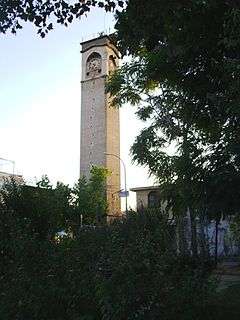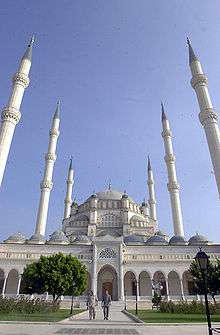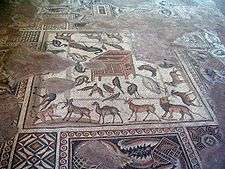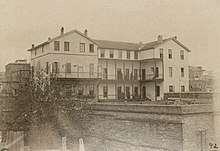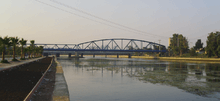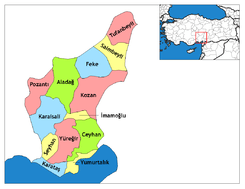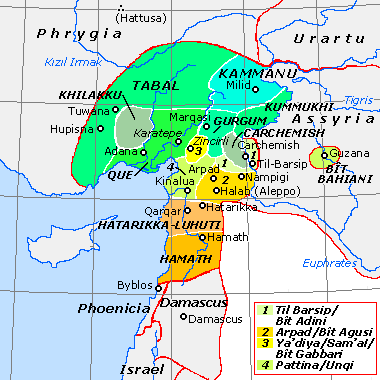Adana
Adana (pronounced [aˈda.na]; Armenian: Ադանա; Ancient Greek: Άδανα, Arabic: أضنة) is a Cilician city in southern Turkey. The city is situated on the Seyhan river, 35 km (22 mi) inland from north-east corner of the Mediterranean. It is the administrative seat of the Adana Province and has a population of 1.77 million,[2] making it the 5th most populated city in Turkey.
Adana | |
|---|---|
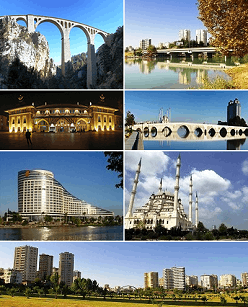 Top: A view from Çukurova, 1st left: Adana station, 1st right: Taşköprü, 2nd left: Sheraton Adana, 2nd right: Sabancı Central Mosque, Bottom: White Houses neighborhood. | |
 Adana Location of Adana | |
| Coordinates: 37°0′N 35°19.28′E | |
| Country | |
| Region | Mediterranean |
| Province | Adana |
| Founded | 6000BC (8020 years ago) |
| Incorporated | 1871 (149 years ago) |
| Districts | Seyhan, Yüreğir, Çukurova, Sarıçam |
| Government | |
| • Type | Mayor-council government |
| • Body | Adana Metropolitan Municipality |
| • Mayor | Zeydan Karalar (CHP) |
| Area | |
| • Total | 1,945 km2 (751 sq mi) |
| Elevation | 23 m (75 ft) |
| Population (2019)[1] | 1,768,860 |
| • Density | 909.44/km2 (2,355.4/sq mi) |
| Time zone | UTC+3 (FET) |
| Postal code | 01xxx |
| Area code(s) | 0322 |
| Licence plate | 01 |
| Website | www |
Adana lies in the heart of Cilicia, a distinct geographical region alternatively known as Çukurova. Home to six million people[3], Cilicia is one of the largest population concentrations in Turkey, as well as the most agriculturally productive area, owing to its large stretch of flat, fertile land. Adding the large population centers surrounding Cilicia, more than 10 million people reside within 2-hours drive from the Adana city center.
Throughout the history, Adana were a market town at the Cilicia plain and one of the gateways from Europe to the Middle East, as it provided the only access on the wide Seyhan river. The city turned into a powerhouse of Cilicia with the Turkic takeover in 1359. The city remained as the capital of the Ramadanid Emirate until 1608, and then the regional administrative center for the Ottoman Empire, Turkey and shortly for the French Cilicia. The city boomed with the breakdown of American Civil War in 1861, and emerged as a hub for international cotton trade. Traditionally a town populated by Armenians and Turks; influx of Armenians, Turks, Greeks, Jews and Alawites at this period, made the city one of the most diverse cities of Anatolia. Economic, social and cultural growth were halted by the Adana massacre, the Armenian Genocide and the 1921 Cilicia evacuation,[4] all devastated the city in the early 20th century. After the eviction of Armenians and Greeks, most of the city's private properties were confiscated in 1923 and were granted to the Muslim/Turks who recently had migrated into the city. After a standstill period, city's economy again boomed in 1950s with the construction of the Seyhan Dam, and the growth continued until 1980s.
Adana in the 21st century, are a center for regional trade, healthcare, public and private services. Agriculture and logistics are significant sectors of the city. The economic decline caused by national policies and de-industrialization since 1990s is reversing, as the city is gaining momentum with the fairs, festivals and entertainment life. The rivalry between the city's football clubs, Adanaspor and Adana Demirspor, is getting national attraction as being the only citywide derby of Turkey that is rooted in socio-economic divisions.
Etymology
It is widely accepted that the city name originates from the Luwian word, a-danu, meaning 'on the river'. In Proto-Indo-European language 'a(n)' is a prefix that means on and 'danu' means river. Many river names in Europe were derived from the same root: Danube, Don, Dnieper and Donets.[5] The earliest time Adana was mentioned was around 2000 BC at the Hittite tablets. With at least 4-millennium of history, Adana is one of the oldest continuously used place names and had only pronunciation changes under different rules.
In Homer's Illiad, the name of the city is mentioned as Adana. For a short while during the Hellenistic era, the city was known as Ἀντιόχεια τῆς Κιλικίας (English: Antioch in Cilicia) and as Ἀντιόχεια ἡ πρὸς Σάρον (English: Antioch on Sarus). On some cuneiforms, the city name was mentioned as Quwê, and as Coa in some other sources which could be the place Solomon had obtained his horses as per Bible (I Kings 10:28; II Chronicles 1:16). Under the Armenian rule, the city was known as Ատանա (Atana) or Ադանա (Adana). An ancient Greco-roman legend mentions that Adana name originates from Adanus, the son of the Greek god Uranus, who founded the city next to the river with his brother.[6] His brother's name, Sarus, was given to the river. An older legend in Accadian, Sumer, Babylonian, Assyrian and Hittite mythologies, originates the city's name to Storm and rain god Adad who lived in the forestry around. There are Hittite manuscripts that were founded in the region regarding this legend. The legend had survived as the Storm and rain god continued to create rain and abundance. The locals had great admiration towards the God and called the region Uru Adaniyya (English: Adana region) in his honour. The city inhabitants were called Danuna.
According to Ali Cevad's Memalik-i Osmaniye Coğrafya Lügatı (English: Ottoman Geography Dictionary), Muslims of Adana originated the city's name to Ebu Süleym Ezene, who was appointed as Wali by Abbasid Caliph Harun al-Rashid.[7] Other than Ezene, Ottoman and Islamic resources also mention the city as Edene, Azana and Batana.
Geography
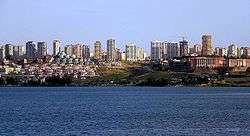
Adana is located at the northeastern edge of the Mediterranean, where it serves as the gateway to the Cilicia plain. This large stretch of flat, fertile land lies southeast of the Taurus Mountains.
From Adana, crossing Cilicia westwards, the road from Tarsus enters the foothills of the Taurus Mountains, eventually reaching an altitude of nearly 4,000 feet (1,200 m). It goes through the famous Cilician Gates, the rocky pass through which armies have coursed since the dawn of history, and continues to the Anatolian plain.
The north of the city is surrounded by the Seyhan reservoir. The Seyhan Dam, completed in 1956, was constructed for hydroelectric power and to irrigate the lower Çukurova plain. Two irrigation channels in the city flow to the plain, passing through the city center from east to west. There is another canal for irrigating the Yüreğir plain to the southeast of the city.
The 37th parallel north passes through the city.
Climate
Adana has a hot-summer Mediterranean climate (Csa) under both the Köppen classification, and a dry-hot summer subtropical climate (Csa) under the Trewartha classification. Winters are mild and wet. Summers are long, hot, humid and dry. The highest recorded temperature was on 8 July 1978 at 45.6 °C (114.1 °F). The lowest recorded temperature was −8.1 °C (17.4 °F).
| Climate data for Adana (1927–2017) | |||||||||||||
|---|---|---|---|---|---|---|---|---|---|---|---|---|---|
| Month | Jan | Feb | Mar | Apr | May | Jun | Jul | Aug | Sep | Oct | Nov | Dec | Year |
| Record high °C (°F) | 26.5 (79.7) |
28.5 (83.3) |
32.0 (89.6) |
37.5 (99.5) |
41.3 (106.3) |
42.8 (109.0) |
44.0 (111.2) |
45.6 (114.1) |
43.2 (109.8) |
41.5 (106.7) |
34.3 (93.7) |
30.8 (87.4) |
45.6 (114.1) |
| Average high °C (°F) | 14.7 (58.5) |
16.1 (61.0) |
19.3 (66.7) |
23.6 (74.5) |
28.2 (82.8) |
31.7 (89.1) |
33.8 (92.8) |
34.6 (94.3) |
33.1 (91.6) |
28.9 (84.0) |
22.5 (72.5) |
16.7 (62.1) |
25.3 (77.5) |
| Daily mean °C (°F) | 9.5 (49.1) |
10.5 (50.9) |
13.4 (56.1) |
17.5 (63.5) |
21.7 (71.1) |
25.6 (78.1) |
28.2 (82.8) |
28.7 (83.7) |
26.1 (79.0) |
21.6 (70.9) |
15.8 (60.4) |
11.2 (52.2) |
19.1 (66.4) |
| Average low °C (°F) | 5.1 (41.2) |
5.9 (42.6) |
8.1 (46.6) |
11.8 (53.2) |
15.6 (60.1) |
19.6 (67.3) |
22.8 (73.0) |
23.2 (73.8) |
20.0 (68.0) |
15.5 (59.9) |
10.6 (51.1) |
6.8 (44.2) |
13.8 (56.8) |
| Record low °C (°F) | −8.1 (17.4) |
−6.6 (20.1) |
−4.9 (23.2) |
−1.3 (29.7) |
5.6 (42.1) |
9.2 (48.6) |
11.5 (52.7) |
14.8 (58.6) |
9.3 (48.7) |
3.5 (38.3) |
−4.3 (24.3) |
−4.4 (24.1) |
−8.1 (17.4) |
| Average precipitation mm (inches) | 107.6 (4.24) |
90.0 (3.54) |
65.4 (2.57) |
51.3 (2.02) |
47.3 (1.86) |
20.4 (0.80) |
6.3 (0.25) |
5.6 (0.22) |
17.8 (0.70) |
42.1 (1.66) |
71.7 (2.82) |
119.1 (4.69) |
644.6 (25.38) |
| Average precipitation days | 12.1 | 10.9 | 10.7 | 10.0 | 7.5 | 3.7 | 1.2 | 1.1 | 3.4 | 6.8 | 8.0 | 11.4 | 86.8 |
| Mean monthly sunshine hours | 139.5 | 149.7 | 186.0 | 213.0 | 282.1 | 318.0 | 334.8 | 322.4 | 270.0 | 229.4 | 177.0 | 136.4 | 2,758.3 |
| Mean daily sunshine hours | 4.5 | 5.3 | 6.0 | 7.1 | 9.1 | 10.6 | 10.8 | 10.4 | 9.0 | 7.4 | 5.9 | 4.4 | 7.5 |
| Source: Turkish State Meteorological Service[8] | |||||||||||||
History
The history of the Tepebağ tumulus in the middle of Adana dates to the Neolithic Period, 6000 B.C., and the time of the first human settlements. It is considered to be the oldest city of Cilicia. A place called Adana is mentioned by name in a Sumerian epic, the Epic of Gilgamesh, but the geography of this work is too imprecise to identify its location.
Ancient times
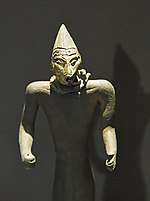
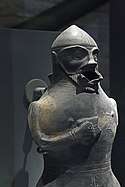
First known people living in Adana and area were the Luwians. They controlled the Mediterranean coasts of Anatolia roughly from 3000BC to around 1600BC. Hittites took over the region which came to be known as Kizzuwatna. Inhabited by Luwians and Hurrians, Kizzuwatna had an autonomous governance under the Hittites protection, but they had a brief independent period from 1500s to 1420s. According to the Hittite inscription of Kava, found in Hattusa (Boğazkale), Kizzuwatna was the kingdom that ruled Adana, under the protection of the Hittites by 1335 BC. Beginning with the collapse of the Hittite Empire c. 1191–1189 BC, Adana originated Denyen sea peoples took control of the plain until around 900BC.[9] Neo-Hittite States founded in the region then after and Quwê state was centered around Adana. Quwê and other states were protected by the Neo-Assyrian Empire, though they had independent periods. After the Greek migration to Cilicia in the 8th century BC, the region was unified under the rule of the dynasty of Mopsos[10] and Adana was established as the capital. Bilingual inscriptions of the ninth and eighth centuries founded in Mopsuestia were written both in Indo-European hieroglyphic Luwian and West Semitic Phoenician. Assyrians took control of the regions several times until their collapse in 612BC. Cilicians founded the Kingdom of Cilicia by the efforts of Syennesis I. The kingdom were independent until the invasion of Achaemenid Empire in 549, then after became an autonomous satrapy of Achaemenids and Macedonians. After Alexander's death, for a time, Adana fell under Ptolemaic dominion, but finally came to the Seleucid Empire. Seleucids ruled Adana until the Kingdom of Armenia made Cilicia their vassal state in 83BC.
Roman-Byzantine, Islamic and Armenian era

Pompey took over entire Cilicia and organized it as a Roman province in 64BC. Adana was of relatively minor importance during the Roman's influential period, while nearby Tarsus was the metropolis of the area. During the era of Pompey, the city was used as a prison for the pirates of Cilicia. The Taşköprü was built in the early 2nd century, and for several centuries thereafter, the city was a waystation on a Roman military road leading to the East. After the permanent split of the Roman Empire in 395 AD, the area became a part of the Byzantine Empire, and was probably developed during the time of Julian the Apostate. With the construction of large bridges, roads, government buildings, irrigation and plantation, Adana and Cilicia became the most developed and important trade centers of the region.
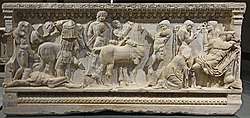
Adana was a Christian bishopric, a suffragan of the metropolitan see of Tarsus, but was raised to the rank of autocephalous archdiocese after 680, the year in which its bishop appeared as a simple bishop at the Third Council of Constantinople, but before its listing in a 10th-century Notitiae Episcopatuum as an archdiocese. The Bishop Paulinus participated in the First Council of Nicaea in 325. Piso was among the Arianism-inclined bishops at the Council of Sardica (344) who withdrew and set up their own council at Philippopolis; he later returned to orthodoxy and signed the profession of Nicene faith at a synod in Antioch in 363. Cyriacus was at the First Council of Constantinople in 381. Anatolius is mentioned in a letter of Saint John Chrysostom. Cyrillus was at the Council of Ephesus in 431 and at a synod in Tarsus in 434. Philippus took part in the Council of Chalcedon in 451[11] and was a signatory of the joint letter of the bishops of Cilicia Prima to Byzantine Emperor Leo I the Thracian in 458 protesting at the murder of Proterius of Alexandria. Ioannes participated in the Third Council of Constantinople in 680.[12][13] No longer a residential bishopric, Adana is today listed by the Catholic Church as a titular see.[14]
Byzantines defended the region from encroaching Islamic Caliphates throughout the 7th century CE, but it was finally conquered in 704 by the Umayyad Caliph Abd al-Malik. During Umayyad rule, Cilicia became a no man's land frontier between Byzantine Christian and Arab Muslim forces.[15] In 746, profiting by the unstable conditions in the Umayyad Caliphate, Byzantine Emperor Constantine V took control of Adana in 746. Abbasid Caliphate took over the rule of the region from Byzantine after Al-Mansur's inauguration to caliph in 756. With the Abbasid rule, Muslims for the first time started settling in Cilicia. Abandoned for more than 50 years, Adana was garrisoned and re-built from 758 to 760. To form a Thughūr on the Byzantine frontier, Cilicia was colonized with the Turkic Sayābija tribe from Khorasan. The city had seen rapid economic and cultural growth during the reign of Harun al-Rashid and Al-Amin. Abbasid rule of the city continued for more than two centuries,[16] and the Byzantines retook control of Adana in 965. The city became part of the Seleucia theme. After the defeat at the Battle of Manzikert in 1071, the emperor Romanos IV Diogenes was removed from reign by a coup. He then gathered a troop to regain his power, though got defeated and had to retreat his troop to Adana. He was forced to surrender by the Garrison in Adana upon receiving assurances of his personal safety. Suleiman ibn Qutulmish, the founder of the Anatolian Seljuk Sultanate annexed Adana, in his campaign in 1084.
Cilicia had been criss-crossed by invading armies and the crusades during this period until it was captured by the forces of the Armenian Principality of Cilicia in 1132, under its king, Leo I.[17] It was taken by Byzantine forces in 1137, but the Armenians regained it around 1170. Armenian era had evolved Adana to a center for handicrafts and international trade. In 1268, a devastating earthquake destroyed much of the city, and Adana was rebuilt from ruins. 80 years later in 1348, Black Death reached the city and caused severe depopulation. Adana remained part of the weakened Armenian Kingdom of Cilicia until 1359, when the city was ceded to the Türkmen supported Mamluk Sultanate who marched into Cilicia and captured the plain. Most Armenians of the city fled to Cyprus after the ceding.
Turkish era
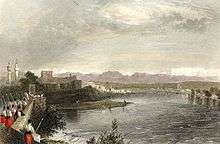
The Mamluks built garrisons in Tarsus, Ayas port and Sarvandikar, and left the administration of Adana plain to Yüreğir Turks who already formed a Mamluk authorized Türkmen Emirate in Camili area in 1352, just southeast of Adana. The Amir, Ramazan Bey, designated Adana as the capital, and headed the Yüreğir Turks in settling the city. The emirate which later on known as the Ramadanid Emirate, were de facto independent throughout the 15th century, by being a Thughūr in the Ottoman-Mamluk relations. In 1517, Selim I incorporated the beylik into the Ottoman Empire after his conquest of the Mamluk state. The Ramadanid Beys held the administration of the new Ottoman sanjak of Adana in a hereditary manner until 1608.
.jpg)

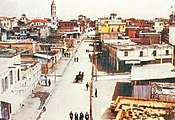
Ottomans terminated the Ramadanid administration in 1608 after the Celali rebellions and commenced ruling directly from Constantinople through an appointed Vali.[18] In late 1832, Vali of Egypt, Muhammad Ali Pasha, invaded Syria, and reached Cilicia. The Convention of Kütahya that was signed on 14 May 1833, ceded Cilicia to the de facto independent Egypt. At the time of ceding, the Adana sanjak population of 68,934 hardly received any urban services.[19] First neighborhood (Verâ-yı Cisr) east of the river was founded and Alawites brought here from Syria to work at the flourishing agricultural lands. İbrahim Paşa, the son of Muhammed Ali Paşa, demolished the Adana Castle and the city walls in 1836. He built the first canals for irrigation and transportation and also built a water system for the residential areas of the town, including wheels (tr:mavra) raising the water of the river for public fountains.[20] After the Oriental crisis, the Convention of Alexandria that was signed on 27 November 1840, required the return of Cilicia to Ottoman sovereignty. The American Civil War that broke down in 1861, faltered the cotton flow to Europe and directed European cotton traders to fertile Cilicia. Adana had evolved to be a hub for cotton trade and one of the most prosperous cities of the Empire within decades. New Armenian, Turkish, Greek, Chaldean, Jewish and Alawite neighborhoods were founded, surrounding the formerly walled city. Adana–Mersin railway line was opened in 1886, connecting Adana to international ports through Port of Mersin. Further migration that had attracted by the large-scale industrialization, inflated the population of Adana to over 107,000 at the turn of the 20th century: 62,250 Muslims (Turks, Alawites, Circassians, Kurds), 30,000 Armenians, 8000 Chaldeans, 5000 Greeks, 1250 Assyrians, 500 Arab Christians and 200 internationals.[21]
Adana massacre
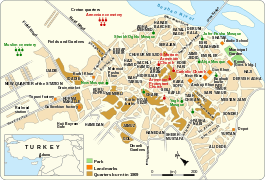
Wealth acquired with the thriving regional economy, doubling of Cilician Armenian population due to flee from Hamidian massacres, the end of autocratic Abdulhamid rule with the revolution of July 1908, empowered the Armenian community and envisioned an autonomous Cilicia. CUP's post-revolution mismanagement of Vilayets, caused pro-diversity Vali Bahri Pasha to be removed from the office in late 1908, and replaced him with the impotent Cevad Bey. Taking that into advantage, Bağdadizade Abdülkadir (Paksoy), the local leader of Cemiyet-i Muhammediye, took almost control of the local governance and led an action plan in entire Cilicia to "punish" Armenians. Rumours of an upcoming Armenian attack, deliberate provocations tensed the Turkish neighborhoods. As soon as the news of countercoup reached Cilicia, enraged members of Cemiyet-i Muhammediye[22] and dissatisfied peasants that were left out of work due to mechanization, flocked to the city on the market day of Tuesday. After staying overnight in the city, the groups together with the local supporters started attacking the Armenian shops from the morning of 14 April 1909. The attacks directed towards the Armenian dwellings later in the day and also spread to rest of Cilicia. Armed Armenians could defend themselves and the clashes lasted until April 17th.
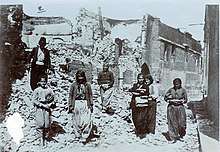
After a week of silence, 850 soldiers from regiments of the Ottoman Army arrived to the city on April 25th. Shots were fired to the tents that soldiers set at the campground, and a rumor immediately spread that the Armenians had opened fire from a church tower. Without even investigating any falsity of the rumor, the military commander Mustafa Remzi Pasha directed soldiers, together with the bashi-bazouks, towards Armenian quarters and for three days; shot people, destroyed buildings and burned down Christian neighborhoods. Pogroms of 25-27 April were much larger than the 14-17 April clashes, and the casualties were almost all Christian.[23]
The Adana massacre of April 1909, resulted in the deaths of 18,839 Armenians, 1250 Greeks, 850 Assyrians, 422 Chaldeans and 620 Muslims. Adding the roughly 2500 disappeared Hadjinian and other seasonal workers, the death roll is estimated around 25,500 in the entire Vilayet. Later in summer, 2000 children died of dysentery and few thousand adults died of injuries or epidemic. The massacre orphaned 3500 children and caused heavy destruction of Christian properties.[24][25] Cevad Bey and Mustafa Remzi Pasha were sacked and sentenced for abuse of power, and on 8 August 1909, Djemal Pasha was appointed as the Vali, who quickly built relations with the surviving Armenian community. With the financial support he could gather, Djemal Pasha founded a new neighborhood, Çarçabuk (now Döşeme), for Armenians within a very short time, ordered the construction of two orphanages and the restoration of destroyed buildings.[22] Cilicia section of the Berlin–Baghdad railway had opened in 1912, connecting Adana to Middle East. In few years, the city had re-gained it's momentum and by the turn of 1915, the Armenian population numbered up to 30,000, close to the figure before 1909.
The city during Armenian Genocide

Early in May 1915, Vali Ismail Hakkı Bey received an order from Constantinople (now İstanbul) to deport the Armenians of the city. Vali was able to delay the deportations and let the Armenians to sell their movable assets to acquire money for the trip. First convoy of deportees consisting of more than 4000 Armenians left the city on May 20th. The Catholicos of Cilicia, Sahak II wrote a letter to Djemal Pasha, then Syria-Cilicia General Vali, to prevent further deportations and the chief secretary Kerovpe Papazian met the pasha in Aley in early June and delivered the message of Catholicos. Djemal Pasha immediately wired the Vali to not to deport more Armenians. With his efforts, Adana Armenians earned an exemption at a summer, while the rest of Cilician Armenians were being deported and hundreds of thousands of Armenian deportees of Western Anatolia were passing through the city. Armenian intellectuals that were deported on April 24th from Constantinople, Rupen Zartarian, Sarkis Minassian, Nazaret Daghavarian, Harutiun Jangülian, and Karekin Khajag were kept in custody at the Vilayet Hall for few days. They could manage to have a meeting with the Catholicos at the Cathedral; their last attempt for survival. Later in June, two prominent leaders, Krikor Zohrab and Vartkes Serengülian were also kept in the city on their final journey towards Diyarbakır.[26]
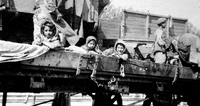
Minister of Interior, Talaat Pasha, wanted to end the exemption of Adana Armenians and sent his second in command in the Ministry, Ali Munif, to the city in mid-August to resume the deportations. Ali Munif immediately deported 250 families from Adana who were accused of insurrection. Public hangings also began. Before the deportations of the rest, Vali could again manage the deportees to sell their assets. As almost a third of the city residents were selling their goods, the city seemed like a site for massive clearance sale. Deportations of 5000 Armenian families in eight convoys started on 2 September 1915 and continued until the end of October. 1000 craftsmen, state officers and the army personnel were exempted from deportations with their families. Unlike the deportees of other Vilayets, a good portion of Adana Armenians were sent to Damascus and further south, thus were avoided from the death camps of Deir ez-Zor by the personal request of Djemal Pasha.[26] At the course of Armenian Genocide, the death rate of the roughly 25,000 Adana Armenians that were deported through out 1915, were a lot lower than the deportees from other regions due to three main factors: No reports of direct killings in and around the city, being deported safely to Damascus area and having money with them to manage their lives on the way and after arriving to their designated locations.
French rule

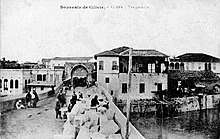
![]()
Kizzuwatna (free) 1500s-1420s
![]()
Denyen Sea Peoples 1190s-c.900
![]()
![]()
![]()
![]()
![]()
![]()
![]()
![]()
![]()
Umayyad Caliphate 704-746
![]()
![]()
![]()
![]()
![]()
![]()
![]()
![]()
![]()
![]()
![]()
![]()
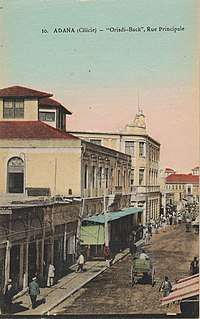
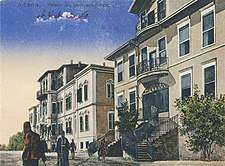
Armistice of Mudros that was signed on 30 November 1918 to end the World War I, ceded the control of Cilicia to France. French Government sent four battalions of the Armenian Legion in December to take over Adana and oversee the repatriation of more than 170,000 Armenians to Cilicia. Returning Armenians negotiated with France to establish an autonomous State of Cilicia and Mihran Damadian, the chief negotiator for Armenians, signed the provisional Constitution of Cilicia in 1919.[4] Pre-war life had resumed with re-opening of the churches, the schools, the cultural centers and the businesses.
The French forces were spread too thinly in Cilicia and the villages that were repatriated came under withering attacks by Turkish Kuva-yi Milliye. Costs and difficulties associated with the repatriation process, growing Arab nationalism in Syria mandate, forced French High Commissoners to meet with Turkish leader, Mustafa Kemal Pasha, several times in late 1919 and early 1920 which resulted in halting the deployment of extra forces to Cilicia.[27] A truce arranged on May 28 between the French and the Kemalists, led to the retreat of the French forces south of the Mersin-Osmaniye railroad. The subsequent evacuation of thousands of Armenians from Sis and its environs and their migration to Adana, raised the number of Armenians in the city to more than 100,000 and crammed the city with refugee camps.[28] On 10 July 1920, to ease the overpopulated south of the railroad, a Franco-Armenian operation forced the local Turkish population to escape north. Roughly 40,000 Turks from Adana and around fled to the countryside and to the mountains north, an event known as Kaç Kaç incident, which lasted 4 days and claimed hundreds of lives.[29] Mihran Damadian declared the autonomy of Cilicia on 5 August 1920, by coming to a consensus with the ethnic communities of the city. French government, however, did not recognize the autonomy and dissolved the Armenian Legion for acts of vengeance on Turks.[26]
With the changing political environment and interests, French further reversed their policy and abandoned all pretensions to Cilicia, which they had originally hoped to attach to their mandate over Syria.[30] Cilicia Peace Treaty was signed on 9 March 1921 between France and Turkish Grand National Assembly. The treaty did not achieve the intended goals and was replaced with the Treaty of Ankara that was signed on 20 October 1921. Based on the terms of the agreement, France recognized the end of Cilicia War and to the withdrawal under the condition of Christian communities' rights to be protected.[31] Armenians who were not satisfied with the guarantees that the treaty offer and who had no trust in Turkish nationalist rule after the catastrophes of 1909 and 1915, had rushed to the Mersin port and Dörtyol, and had evacuated their two-millennium homeland by December 1921. [32] French troops together with the remaining Armenian volunteers withdrew from the city on 5 January 1922. Later in 1922, up to 10,000 Adana Greeks moved to Greece before the policy of Greco-Turkish population exchange got in effect.[4][33] Adana Armenians settled in Lebanon, where they founded Nor Adana (en:New Adana) neighborhood within the mostly Armenian Bourj Hammoud town, just north-east of Beirut.[34] From 1920s, around 60 percent of the Cilician Armenians moved to Argentina. An informal census of 1941 revealed that, 70 percent of all the Armenian Argentines in Buenos Aires had Adana origins.[35]
Modern Turkey
On 15 April 1923, just before the signing of the Treaty of Lausanne, the Turkish government enacted the "Law of Abandoned Properties" which confiscated the properties of Armenians and Greeks who were not present on their property. Adana were one of the cities with the most confiscated property, thus muhacirs from Balkans and Crete, migrants from Kayseri and Darende were relocated in the Armenian and Greek neighborhoods of the city. All types of modest properties, lands, houses and workshops were distributed to them. Large farms, factories, stores and mansions were granted to the Kayseri notables (eg. Nuh Naci Yazgan, Nuri Has, Mustafa Özgür) and to local nationalists (eg. Sefa Özler, Ali Münif) as promised at the Sivas Congress by Mustafa Kemal.[36] Within a decade, the city had a sharp change demographically, socially and economically and lost its diversity by turning into a solely Muslim/Turkish city.[4] Remaining Jews and Christians were hit by the heavy burden of the Wealth Tax in 1942, which caused them to leave Adana, selling their properties way under the value to families like Sabancı, who built their wealth on owning confiscated or undervalued properties. Forcible change in means of production led to abuse of wealth and harsh treatment of labor later in the 20th century, as the new possessors did not have the management attributes that the previous owners had.
The city was hit by a 6.2 magnitude earthquake (1998 Adana–Ceyhan earthquake) on 27 June 1998. The disaster killed 145 and left 1500 people wounded and many thousand homeless in the city and in Ceyhan district. The total economic loss was estimated at about US$1 billion.[37]
Governance
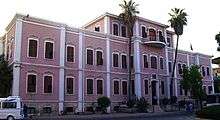
The city of Adana is referred as the area that is within the borders of Adana Metropolitan Municipality. This area covers 30 km2 (12 sq mi) around the City Hall excluding the areas out of the Province.[38] Four levels of government are involved in the administration of the city; national government, provincial administration, metropolitan municipality and the district municipalities. Government of Turkey in Ankara holds most of the power; health, education, police and many other city related services are administered by Ankara through an appointed Governor. National government is also the lawmaker, adjudicator and auditor of all the other levels of government and the neighborhood administration. Semi-democratic provincial governing body, Adana Province Special Administration, has minor powers, dealing mainly with construction and maintenance of primary schools, daycares and other state buildings and some level of social services.[39] Municipal governance is held in a two-tier structure; Metropolitan Municipality forms the upper and the district municipalities form the lower tier. Metropolitan municipality takes care of construction and maintenance of major roads and parks, operating local transit and fire services.[40] District municipalities are responsible for neighborhood streets, parks, operating garbage collection and cemetery services. The district municipalities are further divided into neighborhoods (mahalle), the smallest administrative units of the city.
Metropolitan municipality
Adana Municipality was incorporated in 1871 though the city continued to be governed by the muhtesip system until 1877 by the first mayor Gözlüklü Süleyman Efendi. The first modern municipal governance began with the second mayor Kirkor Bezdikyan and his successor Sinyor Artin. The roads were widened and paved with cobblestone, drainage canals and trenches were opened, more importantly the first municipal regulations were put in effect. After the foundation of the republic, major infrastructure projects were completed and the first planned neighborhoods were built north of the city. Turhan Cemal Beriker served as mayor and governor for 12 years during this period. With the completion of Seyhan Dam in 1956, the city saw explosive growth when then prime minister Adnan Menderes showed special interest in Adana; he initiated large-scale infrastructure projects like citywide underground sewer systems and rezoning of residential areas into roads and public spaces. From 1984 to the present, the cityscape has seen revolutionary changes with the revitalization of Seyhan river and the construction of large parks and boulevards.[41]
Metropolitan Municipality Law was introduced in 1989 and the municipal governance was split between metropolitan municipality and district municipalities. Adana Municipality then became the Metropolitan Municipality and two new district municipalities were founded; Seyhan and Yüreğir. Karaisalı was annexed to the city in 2006, Çukurova and Sarıçam districts were founded in 2008 by the partitioning of Seyhan and Yüreğir districts respectively. On 3 February 2012, Karataş Municipal Council accepted a motion to amalgamate the municipality with Adana, hence Karataş will become the sixth district of the city after the transition process is completed.[42]
Metropolitan municipality consists of three organs; Metropolitan Council, Mayor and the Encümen. Each district municipal council elects one-fifth of their members to represent the district at the metropolitan council. Thus, metropolitan council consists of 35 councilors, ten from Seyhan district, eight from Yüreğir, eight from Çukurova, six from Sarıçam, two from Karaisalı and the metropolitan mayor who is elected directly by the voters.[43] Encümen, the executive committee, consists of ten members, five being metropolitan councilors and the other five are the directors at the metropolitan hall who are appointed to the Encümen by the metropolitan mayor.[44]
Districts
.jpg)
.jpg)
City of Adana consists of the urban areas of the four metropolitan districts; Seyhan, Yüreğir, Çukurova, Sarıçam. Seyhan district is fully within the city limits whereas Yüreğir, Çukurova and Sarıçam districts have rural areas outside the city.
Seyhan district, located west of Seyhan River, is the cultural and business center of the city. D-400 state road (also called Turhan Cemal Beriker Boulevard within the city limits) divides the district into north and south. Seyhan's north of D-400, is economically the most developed part of the city. Hotels, cultural centers, commercial and public buildings line up along D-400. Old town, located south of D-400, is the market place where traditional and modern shops serve the residents. South of the old town is a low-income residential area.
Çukurova district, not to be confused with the Çukurova region, is a modern residential district that lies north of the Seyhan district and south of the Seyhan Reservoir. The district was planned in the mid-1980s to direct the urban sprawl to low-fertile 3000 hectare land north of the city. Named as New Adana, the project consisted of 200,000 homes including villas along the lake shore and high-rise apartment buildings along the newly opened wide boulevards of Turgut Özal, Süleyman Demirel and Kenan Evren.[45]
Yüreğir district, located east of the river, consists mainly of low-income residential areas and large-scale industries. With the construction of new bridges on the river and the extension of metro line to the district, Yüreğir became increasingly important, Adana Court of Justice re-locating to the district and a 47.5-hectare health campus planned to be built in the Kazım Karabekir neighborhood.[46] An extensive urban redevelopment plan is under effect in the district which will convert the neighborhoods of Sinanpaşa, Yavuzlar, Köprülü and Kışla into modern residential areas.[47]
District of Sarıçam lies north and east of Yüreğir, consisting of former municipalities that were amalgamated to the City of Adana in 2008. Some of the large institutions of the city are in Sarıçam: Çukurova University, İncirlik Air Base and the Organized Industrial Region.
Neighborhoods
Neighborhoods (Mahalle) are administrative units within the district municipalities and are administered by the muhtar and the Neighborhood Seniors Council. Although elected by the neighborhood residents, the muhtar is not granted any powers, thus functions as an administrator of the national government. Muhtar can voice neighborhood issues to the district municipality and do have a seat at the Adana City Assembly, an umbrella organization for the coordination of public institutions in the city.[48] Despite the fact that neighborhood administration cannot provide social services nor have funding to increase the involvement of residents in neighborhood issues, many residents still like to identify themselves strongly with their neighborhoods especially in the low-income areas.
There are a total of 254 neighborhoods in the city. Seyhan has 99 neighborhoods, 69 of them in the urban area and 30 are the neighborhoods of the former municipalities and the former villages that converted into neighborhoods. Yüreğir has 99 neighborhoods, 38 in the urban area and 61 rural. There are 29 neighborhoods in Sarıçam, 16 neighborhoods in Çukurova and 11 in Karaisalı district. A neighborhood population can range from 150 to 63,000.[49] Some neighborhoods, especially in the Çukurova district, are very large—almost the size of a town—making resident access to muhtars difficult.
Tepebağ, Kayalıbağ, Kuruköprü, Ulucami, Sarıyakup and Alidede are the historical neighborhoods of Adana. The planned neighborhoods of the republican era, Reşatbey, Cemalpaşa, Kurtuluş and Çınarlı are the core of cultural life in the city. Güzelyalı, Karslılar and Kurttepe are the scenic neighborhoods overlooking the Seyhan reservoir.
Economy

Adana is one of the first industrialized cities, as well as one of the economically developed cities of Turkey. A mid-size trading city until the mid-1800s, the city attracted European traders after the United States, a major cotton supplier, was embroiled with its Civil War. Çukurova farmers exported agricultural products for the first time and thus started building capital. By the start of the 20th century, factories almost all processing cotton, began to operate in the region. Factories were shut down and the economy almost came to a standstill in 1915, after the genocide of Armenians who ran most of the businesses in the city. Foundation of the republic, again accelerated the growth of industrialization by re-activation of closed plants and opening of state-owned ones. With the construction of Seyhan Dam and improvements in agricultural techniques, there was an explosive growth in agricultural production during the 1950s. Large-scale industries were built along D-400 state road and Karataş road. The service industry, especially banking, developed during this period.[50] Rapid economic growth continued until the mid-1980s and was accompanied by the rise of capitalistic greed which attracted movie makers to the region, filming income inequalities and the abuse of wealth.
Extensive neo-liberal policies by then Prime Minister Turgut Özal to centralize the country's economy, caused almost all Adana-based companies to move their headquarters to Istanbul. The decline in cotton planting in the region raised the raw material cost for manufacturing, thus the city has seen a wave of plant closures starting from the mid-1990s.[51] Young professionals fled the city, contributing to Adana's status as the top brain drain city of Turkey. Financial and human capital flight from Adana further increased since 2002 with the current national governing party, AKP, due to neo-liberal centralization policies similar to Özal's and in addition, hidden policy not to invest in major projects in a city nonaligned with AKP version of conservatism. In 2010, unemployment in the city reached a record high of 19.1 percent.[52] After 20 years of stagnation, the economy of Adana is picking up recently with investments in the tourism and service industry, wholesale and retail sectors and the city is re-shaping as a regional center.
Adana was named among the 25 European Regions of the Future for 2006/2007 by Foreign Direct Investment magazine. Chosen alongside Kocaeli for Turkey, Adana scored the highest points for cost effectiveness against Kocaeli's points for infrastructure development, while Adana and Kocaeli tied on points for the categories of human resources and quality of life.[53]
Commerce
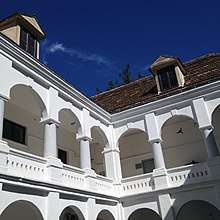
A leading commercial center in southern Turkey, the city hosts regional headquarters of many corporate and public institutions. TÜYAP Exhibition and Congress Center hosts fairs, business conferences and currently it is the main meeting point for businesses in Çukurova.[54] Academic oriented 2000-seater Alper Akınoğlu Congress Center is expected to open in 2012 at Çukurova University campus.[55]
Adana Chamber of Commerce (ATO) was founded in 1894 to guide and regulate the cotton trade and it is one of the oldest of its kind in Turkey. Today the Chamber has more than 25,000 member companies, furthers the interests of businesses and advocates on their behalf.[56] Adana Commodity Exchange, founded in 1913, functions mainly to organize the trade of agricultural produce and livestock in a secure and open manner. The Exchange is located across the Metropolitan Theatre Hall.[57]
Designation of coastal areas of Ceyhan and Yumurtalık districts as Energy-specific Industrial Areas has made Adana an attraction for hotel building. Current capacity of 29 hotels hosting 4200 guests will double in two years; total number of hotel beds rising to 8400.[58] Current 5-star hotels of the city, Hilton, Seyhan and Sürmeli will be complemented by Sheraton and Türkmen hotels on the river bank, Ramada and Divan hotels in the city center, Anemon hotel at the west end which are all currently under construction.[59]
Agriculture
Adana is the marketing and distribution center for Çukurova agricultural region, where cotton, wheat, corn, soy bean, barley, grapes and citrus fruits are produced in great quantities. Farmers of Adana produce half of the corn and soy bean in Turkey. 34 percent of Turkey's peanuts and 29 percent of Turkey's oranges are harvested in Adana.[60] Most of the farming and agricultural-based companies of the region have their offices in Adana. Producer co-operatives play a significant role in the economy of the city. Çukobirlik, Turkey's largest producer co-operative, has 36,064 producer members in ten provinces and services from planting to marketing of cotton, peanut, soybean, sunflower and canola.[61]
Adana Agriculture Fair is the region's largest fair attracting more than 100 thousand visitors from 20 nations. The fair hosts agriculture, livestock, poultry and dairy businesses. Greenhouse and Gardening Fair also takes place at the same time in part of the Agriculture Fair. The fair is organized on a 3.5-hectare area at TÜYAP Exhibition Center every year in October.[62]
Manufacturing
Adana is an industrialized city where large-scale industry is based mostly on agriculture. Food processing and fabricated metal products are the major industries constituting 27 percent of Adana's manufacturing,[63] furniture and rubber/plastic product manufacturing plants are also numerous. As of 2008, Adana has 11 companies in Turkey's top 500 industrial firms.[64] The largest company in Adana, Temsa Global, an automotive manufacturer, has more than 2500 employees and manufactures 4000 buses annually. Marsan-Adana is the largest margarine and plant oil factory in Turkey.[65] Advansa Sasa is Europe's largest polyester manufacturer employing 2650.[66] Organized Industrial Region of Adana has an area of 1225 hectare with 300 plants, mostly medium-scale.
Demographics
As of December 2019, the total population of the four districts is 1,768,860.[67]
The population of the four districts of Adana since 2008 are:
| District | City Population | ||||||||||
|---|---|---|---|---|---|---|---|---|---|---|---|
| 2008 | 2009 | 2010 | 2011 | 2012 | 2014 | 2015 | 2016 | 2017 | 2018 | 2019 | |
| Seyhan | 752,308 | 722,852 | 723,277 | 757,928 | 764,714 | 779,232 | 788,722 | 797,563 | 800,387 | 793,480 | 796,286 |
| Yüreğir | 411,299 | 415,047 | 417,693 | 421,692 | 416,302 | 419,240 | 419,011 | 419,902 | 424,999 | 415,198 | 414,574 |
| Çukurova | 267,453 | 327,460 | 343,770 | 326,938 | 335,733 | 353,680 | 359,315 | 362,351 | 364,118 | 365,735 | 376,390 |
| Sarıçam | 86,727 | 90,879 | 99,313 | 103,232 | 111,976 | 143,547 | 150,425 | 156,748 | 163,833 | 173,154 | 181,610 |
| Total | 1,517,787 | 1,556,238 | 1,584,053 | 1,609,790 | 1,628,725 | 1,695,699 | 1,717,473 | 1,736,564 | 1,753,337 | 1,747,567 | 1,768,860 |
Two-thirds of the residents of Adana live west of the Seyhan River, where the city was first founded. Urban sprawl east of the river is limited due to large institutions such as Çukurova University and Incirlik Air Base. Seyhan is the most diverse district, accommodating all ethnic groups.
The major ethnic groups in Adana are the Turks, followed by Arabs and Kurds. Population growth slowed between 1885 and 1927 because of the Adana Massacre and the Armenian deportations, with the numbers only being replenished, rather than increased, by refugees brought in from the Balkans as part of the Population Exchange of 1923. The first Turks moved to the city from Central Asia around the 11th century. In the early 14th century, several Türkmen tribes were settled after Mamluks took control of Çukurova.[68] An Ottoman tax register from 1526 records 16 Turkish residential areas, but only one Armenian and none that were Greek, Jewish, Kurd or Arab.[69] During the 17th century more Armenians and Greeks settled in the city; according to Evliya Çelebi there was also an Arab population.[69]
| Historical population | ||
|---|---|---|
| Year | Pop. | ±% |
| 1885 | 69,266 | — |
| 1908 | 107,450 | +55.1% |
| 1927 | 72,577 | −32.5% |
| 1955 | 100,367 | +38.3% |
| 1980 | 574,515 | +472.4% |
| 2000 | 1,130,710 | +96.8% |
| 2019 | 1,768,860 | +56.4% |
Arabs are concentrated in Karşıyaka quarter of Yüreğir. New generations of Arabs do not speak Arabic as they are mostly assimilated into Turkish culture. The demography of the city changed significantly in the 1990s after the massive migration of Kurds, many of them being forced to leave their villages in the southeast at the peak of Turkey–PKK conflict.[70] Kurds mostly live in southern neighborhoods of the city.[71] Conos, a tribe of Romani people of Romania, settled in Adana during the Balkan Wars. Conos mainly live around Sinanpaşa neighborhood. Around 8,000 Romani people live in Adana Province, including Conos.[72] There is a sizeable community of migrants from the Balkans and Caucasia, who also settled in Adana during the Balkan Wars and before.
An estimated 2,000 families of Crypto-Armenians live in Adana, identifying themselves as Arabs, Kurds or Alevis for the last century.[73] There is still an active Armenian Catholic Church in the Old Town, built in 1909. In addition, there are a large number of descendants of the Armenian children given to Muslim families to be fostered in 1915, either by their Armenian parents or by Ottoman officials. Armenians and Greeks constituted half of the population of Adana before 1915.[74] Most Adana Armenians now live in Buenos Aires, Argentina where they form majority of the Armenian Argentines there.[75]
Adana is home to a community of around 2,000 British and Americans serving at the Incirlik NATO Air Base. Before 2003, the community numbered up to 22,000, but declined when many troops were stationed in Iraq.[76]
Similar to other cities on the Mediterranean and Aegean coasts, secularism is strong in Adana. Among the people with faith, the majority of the residents adhere to Sunni Islam. The majority of Turks, most of the Kurds and some of the Arabs are Sunni Muslim. Adana is also a stronghold of Alevism, many Alevis having moved to the city from Kahramanmaraş after the incidents in 1978. Arabs of Adana are mostly Alawi, which is often confused with Alevis. Alawi Arabs are locally known as Nusayri or Fellah. Arabs from Şanlıurfa Province are Sunni Muslims. There is a tiny community of Roman Catholics and a few Jewish families.
Cityscape

Architecture
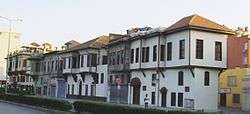
The golden age for the architecture of Adana was the late 15th and 16th centuries when Ramadanid principality chose Adana as their capital. The city grew rapidly during that period with many new neighborhoods being built. Most of the historical landmarks of Adana were built during this period, thus Mamluk and Seljuqid architecture are dominant in Adana's architectural history. Taşköprü is the only remaining landmark from the Roman-Byzantine era, and few public buildings were built during Ottoman rule. Adana is home to modern Turkey's historic Armenian architecture, which can be found behind the city's central modern buildings.
The first traces of settlement in the quarter of Tepebağ, can be traced to the neolithic age. The quarter is next to the Taşköprü stone bridge, situated on a hill which gave its name Tepebağ (Garden on the hill). The city administration has launched a campaign to preserve the heritage of this area, particularly the Ottoman houses. Atatürk stayed in one of these houses on Seyhan Caddesi which now houses the Atatürk Museum.
Several bridges cross the Seyhan river within the city, the most notable among them is the Taşköprü, a 2nd-century Roman bridge.[77] Currently used by pedestrians and cyclists, it was the oldest bridge in the world to be open to motorized vehicles until 2007. Demirköprü is a railway bridge that was built in 1912 as part of the Berlin-Baghdad Railway project. Regülatör bridge, at the southern section of the city, is a road bridge as well as a regulator for the river water. There are also three footbridges, Seyhan and Mustafakemalpaşa road bridges, the bridge of the metro and the bridge of the motorway spanning the river.
Büyük Saat (The Great Clock Tower), built by the local governor of Adana in 1882, is the tallest clock tower in Turkey rising 32 m (104.99 ft) high. It was damaged during French occupation, but was rebuilt in 1935, and its image can be found in the city's coat of arms. Kazancılar Çarşısı (Bazaar of Kazancilar), founded around the Büyük Saat.
Ramazanoğlu Hall was built in 1495 during the reign of Halil Bey. A three-story building, made of stone and brick, it is one of the oldest examples of a house in Turkey. This hall is the Harem section, where the Ramadanid family lived. Selamlık section, where the government offices were, no longer exists.
Çarşı Hamam (Turkish bath of the Bazaar) was built in 1529 by Ramazanoğlu Piri Pasha and it is the largest hamam in Adana. It is built with five domes and the inside is covered with marble. During the time it was built, water was brought from Seyhan River by water wheels and canals.[78]
Irmak Hamam (Turkish bath of the River), located next to Seyhan District Hall, was built in 1494 by Ramazanoğlu Halil Bey on the ruins of an ancient Roman bath. Its water comes from the river. Other historical hamams in the city are Mestenzade Bath and Yeni Bath.
Mosques [[FileFile:Adana_Ulu_Camii_8648.jpg|thumb|left|Ulu Cami
Sabancı Merkez Camii, though not being historical, is the most visited mosque in Adana, as it is one of the largest mosques in the Middle East. Built in loyalty to Ottoman Architecture, the mosque was opened in 1998 to a capacity of 28,500 prayers. The mosque has six minarets, four of them being 99 meters high. Its dome has a diameter of 32 meters and is 54 meters above the praying area. It is located on the west bank of Seyhan River at the corner of Seyhan Bridge and can be seen from a wide area.[79]
Ulu Cami, a külliye built in 1541 during Ramadanid era, is the most interesting medieval structure of Adana with its mosque, madrasah and türbe. The mosque is of black and white marble with decorative window surrounds and it is famous for the 16th century Iznik tiling used in its inner space. The minaret is unique with the Mamluk effects it bears and with its orthogonal plan scheme.
Yağ Camii was originally built as the Church of St. James, then converted into a mosque by Ramazanoğlu Halil Bey in 1501.[80] His successor Piri Mehmet Paşa added its minaret in 1525 and its madrasah in 1558. It is in the Seljuqid Grand Mosque style and has an attractive gate made of yellow stone.
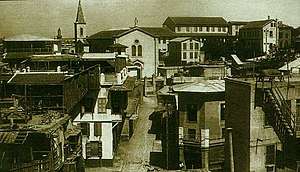
Yeni Camii (New Mosque) was built in 1724 by Abdülrezzak Antaki, and is still known as Antaki Mosque by some. The influence of Mamluk architecture is visible. It is built in rectangular order and has an interesting stonework on its south walls.[81]
Alemdar Mescidi, Şeyh Zülfi Mescidi, Kızıldağ Ramazanoğlu Mosque, Hasan Aga Camii (16th Century wooden architecture constructed without nails) are some other mosques having historical value.
Churches
In the 19th century, the city had four churches; two Armenian, one Greek and one Catholic. Saint Paul Church (Bebekli Kilise) is a Roman Catholic church that was built in 1870. It is located in the old town, close to 5 Ocak Square and currently serves the Roman Catholic and the Protestant communities.
Agios Nikolaos Greek Orthodox Church was built in 1845 in the Kuruköprü area and was converted into a museum in 1950. The church was restored to its original state and purpose in 2015 and is renamed Kuruköprü Monumental Church.
Armenian Church on Ali Münif Street, at midpoint between Yağ Camii to Büyüksaat, was converted into a Ziraat Bank branch during the Republican Era. Surp Asdvadzadzin Armenian Apostolic Church on the Abidinpaşa Street which served until 1915, was used as a movie theatre until 1970, and then demolished by the government and the Central Bank (Merkez Bankası) regional headquarters was built in its stead.[82]
Parks and gardens
Adana has many parks and gardens.[83] Owing to the warm climate, parks and gardens are open all year long without the need of winter maintenance.
Recreational pathways on both banks of Seyhan river cross the entire city from south end to Seyhan Reservoir. Pathway then connects to Adnan Menderes Boulevard which follows the southern shores of Seyhan Reservoir, and the wide sidewalks of the boulevard extend the pathway to the west end of the reservoir. Dilberler Sekisi is the most scenic part of the pathway which is along the west bank, in between the old and the new dam. Recreational pathway along the north side of the Grand Canal goes from east end to west end of the city, crossing Seyhan river from old dam's pathway. Some sections of this pathway have not yet been completed. Once completed, within the city there will be almost 30 kilometres (19 miles) of continuous recreational pathway connecting several parks.
Merkez Park (Central Park) is a 33-hectare urban park that is located on both banks of Seyhan river, just north of Sabancı Mosque. With a 2100-seater amphitheatre, a Chinese Garden, and two cafes, it is the main recreational area of the city. In the park, there is a Rowing Club which serves recreational rowers.
Süleyman Demirel Arboretum is a large botanical garden containing living collections of woody plants intended partly for the scientific study of Çukurova University researchers. The arboretum is also used for educational and recreational purposes by city residents. 512 species of plants exist in the arboretum.[84]
Atatürk Park is a 4.7-hectare city park built during the first years of the Republic. It is centrally located in the commercial district. The park holds a statue of Atatürk and hosts public ceremonies.
Çobandede Park is a 16.5-hectare park at the west shore of Seyhan Reservoir. It is situated on a hill overlooking the reservoir. The park has the tomb of Çoban Dede, a wise man from Karslı Village.
Yaşar Kemal Woods is a hiking area on the east bank of Seyhan river across Dilberler Sekisi. It is dedicated to Çukurova native writer Yaşar Kemal. Çatalan Woods is a large recreational area between Çatalan and Seyhan reservoirs, north of the city, in the Karaisalı district.
Society and culture
One of the major elements that define the society of Adana is the agriculture-based living and its extension, agriculture-based industrial culture. However, developments in industrial life, improvements in transportation, effects of communication and massive migrations have affected the unique culture of Adana. Similar to other cities in Turkey, the culture in some sections in the city are very distinct from each other.[85]
Cuisine
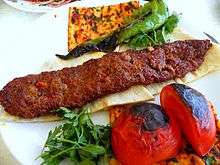
Adana cuisine is influenced mainly from Yörük, Arabic and Armenian cuisine and the city has kept up its traditions. Spicy, sour and fatty dishes made of meat (usually lamb) and bulghur are common. Bulghur and flour are found in all Çukurova kitchens. In almost every home, red pepper, spices, tahini, a chopping block and pastry board can be found. The bulghur used in cooking is specific to Adana, made from dark colored hard wheat species with a preferred flavor.[86]
Adana Kebab, called "Kebap" locally, is a kebab made from minced meat. Since it can be found at all kebab restaurants in Turkey and at most Turkish restaurants around the world, the Adana name still suggests kebab to many people. Adana Kebab is the most popular dining choice in Adana, although foods from other cultures are becoming increasingly popular. Besides many kebab restaurants, there are also many kebab serving vendors in the older streets of Adana.

Adana Kebab is usually served with onion salad, green salad or with well-chopped tomato salad. Rakı and Şalgam usually accompany it as drinks. There are many varieties of salads typical to the city. Radish salad with tahini is popular and it is found only in the Çukurova region. Şalgam and pickle juice are the drinks of the winter and aşlama (licorice juice) is the choice of drink in summer.
One of the famous sweets of Turkey called "Sweet Sausage" originated from Adana. It was invented by Sir Duran O. during the First World War, around 1915 Seker Sucugu.
Vegetable dishes are also popular in the city. Besides tomato paste, pepper paste is used in almost every dish. The city is also famous for its Şırdan a kind of home-made sausage stuffed with rice, and eaten with cumin; paça, boiled sheep's feet; bicibici (pronounced as bee-jee-bee-jee) made from jellied starch, rose water and sugar is served with crushed ice and consumed especially in summertime. Furthermore, the city has a number of famous desserts, such as Halka Tatlı, a round-shaped dessert, and Taş Kadayıf, a bow-shaped dessert. Several types of fruit, including the apricot, are native to this area.
Arts and entertainment
Performing arts
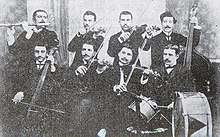
Çukurova State Symphony Orchestra performed its first concert in 1992 and since then, the orchestra performs twice weekly from October to May at the Metropolitan Theatre Hall. The orchestra consists of 39 musicians and conducts regular tours in Turkey and abroad.
Adana State Theater opened its stage in 1981 at the Sabancı Cultural Center. It performs regularly from October to May.[87] Adana Town Theatre was founded in 1880 by governor Ziya Paşa to be the first theater in Adana. In 1926, the theater moved to the newly-built Community Center. Town Theatre currently performs weekly at the Metropolitan Theatre Hall and the Ramazanoğlu Center. Seyhan Town Theatre and Seyhan Folkloric Dances are weekly events at the Theater Hall of Seyhan Cultural Center.
Amphitheaters in Adana host performances from April to November. Mimar Sinan Amphitheater, the largest in Adana, can accommodate 8,000 guests and hosts concerts and movies. It is located at the west bank of the Seyhan River. 2,100-seater Merkez Park Amphitheater, 3,000-seater Çukurova University Amphitheater and Doğal Park Amphitheater in Çukurova District also host theaters, concerts and cinemas. Recently, historic buildings have been restored and converted into cultural centers. The 515-year-old Ramazanoğlu Hall and 130-year-old former high school for girls (now called the Adana Center for Arts and Culture) serve as cultural centers hosting art exhibitions and cultural events.
Museums and art galleries
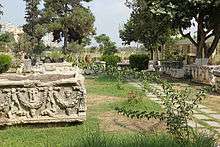
Adana Archaeological Museum was opened in 1924 as one of the oldest ten museums in Turkey. It moved to its current location at the west corner of Seyhan Bridge in 1972. The museum exhibits archeological works from all over Çukurova. Notable works are the two Augustus statues from Hittites, Achilles Sarcophagus depicting Trojan War and statues from Magarsus and Augusta ancient cities.
Adana Ethnography Museum was opened in 1983 after Archeological Museum moved to its new location. In the front and back yard there are epitaphs and gravestones of Adana's leading figures of the 17th century. In the west yard, there are inscriptions of Taşköprü, Misis Bridge, old City Hall and Bahripaşa Fountain. Inside, there are clothing, jewellery and weaponry of Yörük villagemen.
Atatürk Museum exhibits War of Independence and first years of Republic at the mansion where Atatürk stayed during his trips to Adana.
Misis Mosaic Museum, located on the city's far east end at the west bank of Ceyhan river, exhibits mosaics that were on the floor of a 4th-century temple in the ancient city of Misis. The mosaic depicts Noah and 23 birds and poultry that he took onto the ark during the Flood. The museum also exhibits the works that were excavated from Misis Tumulus.[88]
Karacaoğlan Museum of Literature, Adana Museum of Cinema, Yeşiloba Martyrs' Museum, Mehmet Baltacı Museum of Photography and Adana Urban Museum are other noteworthy museums in the city, many of them located in restored historical buildings.[89] State Fine Arts Gallery was opened in Sabancı Cultural Center in 1982. It carries 59 plastic pieces of art. 75.Yıl Art Gallery in Atatürk Park, Adana City Hall Art Gallery and Art Gallery in Seyhan Cultural Center are the other public art galleries.
Festivals
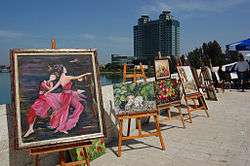
Altın Koza International Film Festival is one of the top film festivals in Turkey, taking place since 1969. During the Altın Koza of 2009, 212 international films were shown in 11 movie theatres across the city. Long Film Contest, International Student Film Contest and Mediterranean Cultures Film Contest are held during the festival.
International Sabancı Theater Festival is held every year in April since 1999. At the festival in 2011, 461 artists from 17 ensembles (10 local and 7 international) performed plays on the stage at the Sabancı Cultural Center. The festival's opening show was staged on the Seyhan River and Taşköprü by Italian ensemble Studio Festi. "Water Symphony" show was greeted by thousands of people with great enthusiasm.[90]
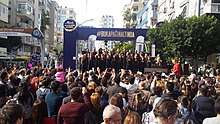
Orange Blossom Carnival is held every April, inspired by the scent coming from the city's orange tree-lined streets. The carnival parade of 2015 attracted more than 90 thousand people—the highest attendance ever in an outdoor event in Adana.[91] Organized concerts and shows in the city's squares, parks and streets are accompanied by spontaneous street celebrations.
International Çukurova Instrumental Music Festival is a two-week long festival held annually in Adana, Antakya and Gaziantep. In 2009, the festival took place for the fifth time with an opening concert from Çukurova State Symphony Orchestra. Baritone Marcin Bronikowski, pianist Vania Batchvarova, guitarist Peter Finger, cellist Ozan Tunca and pianist Zöhrap Adıgüzelzade were some of the musicians who performed at the festival.[92]
Çukurova Art Days is a regional festival that takes place yearly since 2007. In 2012, the festival took place on 22–26 March in Adana, Mersin, Tarsus, Antakya, İskenderun, Silifke, Anamur and Aleppo. There were 94 events including concerts, poetry, exhibitions, talks and conferences.[93]
13 Kare Arts Festival began in 1999 as a festival of photography dedicated to 13 photographers of Adana who died in an accident during an AFAD (Adana Photography Amateurs Association) trip. The festival then expanded to include other arts. During the festival, exhibitions of nature, undersea and architecture photography, puppet shows, shadow theater and several concerts are held. The festival takes place every December.
Adana Literature Festival is held every April at Adana Center for Arts & Culture. Around 100 writers, poets and critics participate in the festival and give talks, make up panels and make presentations.
Nightlife
The city was well known for its vibrant nightlife and many pavyons from the 1950s to the 1980s. Although some were family entertainment places, pavyons mostly functioned as adult entertainment clubs, similar to hostess clubs of Japan, with live music, usually two-storey, a stage and a lounge with tables lined up at the main floor and private rooms at the upper floor.[94] The first pavyons opened in the city by 1942 with the arrival of English workers who worked on the Adana-Ulukışla road that was funded by the British Government to persuade Turkey to form a front in World War II.[95] As Çukurova cotton was valued by the early 1950s, the surplus took landowners to the pavyons which opened more and more along the Seyhan river. In the 1960s, rapid industrialization brought more men to pavyons not only from the city, but from a wide region including Istanbul and Ankara, thus Adana was named Pavyon Capital of Turkey. Many popular singers took the stage at and owe their fame to the pavyons of Adana.
Pavyons led the way to Western-style pubs and night clubs by the late 1980s with the socio-economic changes in Adana. The traditional entertainment district is Sular, near Central Station, but the pubs and clubs nowadays are spread throughout the city. The bigger clubs such as Life Legend, Uptown, Casara and Lava host world star singers at their elegant locations, mostly along the river and the lake. There are still two active pavyons, Afrodit and Maksim, but adult entertainment is directed mostly to what is known locally as tele-bars. Tele-bars are licensed as regular pubs, but function as places where bargirls entertain customers and usually hook with them afterwards. There are around 20 tele-bars mainly in the city center and around the old dam.[96]
A hundred-year-long tradition of kebab, liver and rakı in the Kazancılar Bazaar, with street music and dances, turned into a festival since 2010, with all-night entertainment. World Rakı Festival, held the second Saturday night of December, attracts more than 20 thousand people to the old town.[97]
Sports

Athletic sport life progressed in Cilicia in the early 20th century with the coaches that were invited to Adana from Istanbul. Varag Pogharian and Mateos Zarifian played an important role in the organization of the athletic movement and the first sports clubs in the city were founded by the Armenian community. Adana Türkgücü were founded in 1913 by Ahmet Remzi Bey and İsmail Sefa Bey in alliance with the Istanbul Türkgücü club that is initiated by the Committee of Union and Progress.[98] Athletic clubs of Adana joined the Cilician Olympic Games that were held on April 1914 at a venue north of Dörtyol, first of its kind in the region.[99] Adana İdman Yurdu, Adana Türk Ocağı, Seyhanspor and Milli Mensucat clubs were founded in the city in 1920s, all joining the Çukurova Football League that was established in 1924 with the clubs from other Cilician provinces. Adanaspor that were founded in 1932 and Adana Demirspor that were founded in 1940, later on joined the Çukurova League.
Football is the most popular sport in Adana; basketball, volleyball and handball are also played widely at professional and amateur levels. Warm weather make the city a haven for sports like rowing, sailing, swimming and water polo. Horse racing and horse riding are also popular. Bi-annual Men's European Wheelchair Basketball Championship took place in Adana on 5–15 October 2009. Twelve countries competed at the event and Italy won the title after a final game against Turkey.[100] Adana also hosted the 2013 IWBF Men's U23 Wheelchair Basketball World Championship.[101] 1967 Women's European Volleyball Championship was organized in Turkey and Adana was a host city together with Istanbul, Ankara and İzmir. Group C games are played in Adana at the Menderes Sports Hall.[102]
| Club | Sport | League | Venue (capacity) | Founded |
|---|---|---|---|---|
| Adanaspor | Football (men) | TFF First League | 5 Ocak Stadium (14,805) | 1954 |
| Adana Demirspor | Football (men) | TFF First League | 5 Ocak Stadium (14,805) | 1940 |
| Adana İdmanyurdu | Football (women) | First Football League | Gençlik Stadium (2000) | 1993 |
| Kiremithanespor | Football (men) | Turkish Regional Amateur League | Kaynak Kardeşler Stadium (2000) | 1979 |
| Adana Aski | Basketball (women) | Women's Super League | Menderes Sports Hall (2000) | 2000 |
| Adanaspor | Basketball (men) | Basketball Second League | Menderes Sports Hall (2000) | 2006 |
| ABB Şakirpaşa | Handball (women) | Women's Super League | Yüreğir Serinevler Arena (2000) | 2012 |
Adanaspor and Adana Demirspor are the two clubs of Adana that appear in Turkish Professional Football League. After 12 years, Adanaspor returned to Super Lig,[103] in which they had competed for 21 years and were the runner up in 1980–81 season. Adanaspor also performed at the UEFA Cup for three years. Adana Demirspor, currently performing at the TFF First League, was the runner up at the Turkish Cup in 1977–1978 season and performed at the SuperLig for 17 years. Both teams share 5 Ocak Stadium as their venue, and the matches between them are known as the Adana derby, an archrival atmosphere that is found in only three cities in Turkey. Kiremithanespor of the Yüreğir district, compete at the Turkish Regional Amateur League. In women's football, Adana İdmanyurduspor competes in the First Football League, and plays their home games at the Gençlik Stadium.
Adana ASKİ are the major clubs in Women's Pro-Basketball—both performing in the Turkish Women's Basketball League (TKBL). Adana ASKİ was founded in Ceyhan in 2000, under the name 'Ceyhan Belediyespor', and renamed and moved to Adana in 2014. After the move, the club performed the best season ever (2014–15), playing in the final at the Turkish Women's Cup and semi-final at the TKBL First Division. Adana ASKİ also play their home games at Menderes Sports Hall. Adanaspor, relegated to the third tier of the Turkish Men's Basketball League in 2016,[104] playing their home games at the Menderes Sports Hall. Wheelchair basketball clubs, Adana Engelliler and Martı Engelliler appear in the first division of the Turkish Wheelchair Basketball League, both playing their home games at the Serinevler Sports Hall.
Professional volleyball club Adana Toros was promoted to the top flight of the Turkish Men's Volleyball League on 12 April 2016 at the play-off finals in Bursa.[105] Adana Toros play their homes games at the Menderes Sports Hall.[106] The city's handball club, Şakirpaşa HEM, promoted to the Turkish Women's Handball Super League on 21 April 2016, at the play-off finals in Ankara.[107] The venue of Şakirpaşa is Yüreğir Serinevler Arena.[108]
Water sports have been recreationally and competitively the traditional sports of Adana. Water polo team of Adana Demirspor is a legend in the community, joining the Turkish Waterpolo League in 1942 after the first modern water sport venue of Turkey, Atatürk Swimming Complex, opened in Adana in 1936. The team has a record 22 years of straight championship title in Turkish Men's Waterpolo League, 17 years of it without losing a game and thus their given name "Unbeatables". Demirspor has a total of 29 championship titles.[109] Rowing became a popular sport in Adana in the last 20 years. Rowing competitions are held all year long on Seyhan River and Seyhan Reservoir. Metropolitan Rowing Club and Çukurova University SK compete at national and international level. Sailing competitions[110] are also held at Seyhan Reservoir all year long. Adana Sailing Club performs at sailing competitions in different categories. In swimming, Erdal Acet of Adana Demirspor is a prominent figure in Adana, who broke the record of swimming Canal La Manche (English Channel) in 9 hours and 2 minutes in 1976. Recreationally, the lack of swimming pools made Seyhan River and the irrigation canals attractive for swimmers who want to cool off from the hot and humid summers. Due to almost 100 people suffocating every year, the Metropolitan Municipality built and opened 41 swimming pools over the last 15 years.[111]
Adana Half Marathon was inaugurated in 2011 on a national level with the participation of 223 athletes. In 2012, the marathon gained IAAF International Marathon status and hosted 610 athletes from 10 nations.[112] The marathon takes place on the first Sunday following 5 January, Adana's independence day. Master Men, Master Women and Wheelchair competitions, as well as 4 kilometres (2 miles) Public Run are held during the event. The racecourse follows the historic streets of Adana and the streets along the Seyhan river.[113]
Adana is one of the cities of Turkey where horse racing is highly popular. Yeşiloba Hippodrome is traditionally one of the four race courses of Turkey, hosting horse racing competitions from October to May. Adana Equestrian Club is the largest center of horse riding in Turkey, hosting national and international competitions.
Contemporary life
Media
Media in Adana runs by national and local agencies. Çukurova Journalists Union is the umbrella organization for the local media in the region.
There are several newspapers published daily in Adana, the most popular ones being the Yeni Adana, Ekspres, Toros, Bölge and 5 Ocak papers. Yeni Adana is the oldest newspaper and dates back to 1918.[114] The newspaper played a significant role in the independence movement after the First World War. Most newspapers in Adana serve not only the city but the Çukurova region. Many national newspapers have their regional publishing centers in Adana. Hürriyet publishes a supplement paper, Hürriyet Çukurova, the most popular regional newspaper, that has circulation of 48,000. Sabah's regional supplement paper, Güney, is also published in Adana.
Kanal A is the longest serving TV broadcaster in Adana, Çukurova TV, Akdeniz TV, Koza TV and Kent TV are the other major broadcasters. There are numerous local radio channels and TRT's Çukurova Radio can be listened to in the city.
Shopping
Çakmak Street is the traditional shopping street that is located in the old town. Several attempts by the city to designate it as a pedestrianised street was unsuccessful because traffic flow could not be diverted to another street. There are several historical bazaars around Büyük Saat and Yağ Camii. Covered markets around Saydam street, Kilis and Mısır bazaars, were once a haven for shopping for quality foreign goods.
Ziyapaşa Boulevard is the street of elegance where expensive brands are located. The street runs from D-400 state road to the Central Train Station and the shops are concentrated towards the north end. The streets around Ziyapaşa and the streets of northern Adana, Özal, Demirel and Evren boulevards also have high-end shops.
There are four modern shopping malls in the city. Galleria was the first to be built in the early 1990s but did not become popular due to administrative issues. M1 and Carrefour malls were built during the late 1990s at the west end of the city. Recently opened Optimum Outlet is the first mall east of the river and is also the closest to the city center. The mall has a view of the river and the Merkez Park.
Education
Public, private and not-for-profit foundation institutions are located in Adana. Primary and secondary education in the city is regulated by the provincial directorate of the national Ministry of Education which also administers the state schools.
There are 282 public and 12 private primary schools which pupils attend from grades 1 to 8. From grades 9 to 11, pupils go to one of the 85 public and 26 private high schools. Notable high schools of the city that require an examination to enter are the state-owned Adana Fen, Adana Anadolu, and the private Gündoğdu and Bilfen. Adana Gundogdu Schools is the largest private School in Adana and is increasing in size every year. There are six public and six private schools for pupils with special needs. Nine Community Training Centers support adult residents to improve their skills.[115]
Ramazanoğlu Library was founded in 1923 by combining two smaller libraries. The library moved to its current location in the Sabancı Cultural Center in 1976 and renamed as Adana Public Library.[116] The library also has a branch in the Karacaoğlan Museum of Literature. Seyhan, Yüreğir, Sarıçam and Karaisalı also have district public libraries administered by each district. Adana City Library is specific on publications about Adana and Çukurova's history, culture and has a good collection of photography and films about the city. City Library is located in the Adana Center for Arts and Culture.[117]
Çukurova Book Fair took place for the fifth time in 2012, hosting 182,450 visitors from Çukurova and neighboring regions. 205 publishers and volunteer organizations had stands, more than 50 cultural events were performed and 300 authors were present to meet the readers. At the same time, Çukurova Education Fair was organized at the Tüyap Exhibition Center with the participation of 45 education institutions.[118]
The city has large ethnic communities and education conducted in unofficial languages is only at institutions that do not get government support. Few of these institutions teach Arabic and Kurdish in Adana. The requirement for taking admission tests to high schools, universities and to a career in national public services led to the opening of more than one hundred cram schools (Turkish: dershane) in the city since 1984 which added extra schooling and financial burden to residents.[119]
Universities
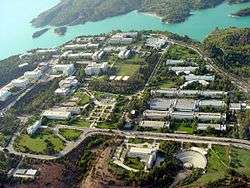
There are two state universities and one foundation university in the city, and there is a second foundation university just outside the city. Universities are regulated by the Council of Higher Education (YÖK).
Çukurova University is a state university located at the east shores of Seyhan Reservoir. In 2008, with 3 faculties, it is placed among the top 500 universities of the world according to research conducted by Blackwell Publishing, Quacquarelli Symonds and The Times.[120][121] The university was founded in 1973 with the union of the colleges of Agriculture and Medicine. Its campus has many cultural, social and athletic facilities for its 40,000 students.[122]
Adana University for Science and Technology is a recently opened state university that has nine faculties, two institutions and a college.[123]
Çağ University is a not-for-profit tuition-based university founded in 1997. The university is 20 kilometres (12 miles) away from the city center at approximately midway to Tarsus. Most of its 2,500 students commute from Adana, Tarsus and Mersin.
Kanuni University is a recently opened, tuition-based university founded by the Çukurova Education and Culture Foundation.
Healthcare
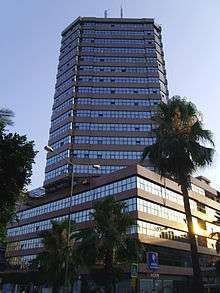
Adana is a major health center to a wide region from Mediterranean to Southeastern Anatolia. There are four university hospitals, eight state hospitals and seven private hospitals in the city.
Hastaneler (Hospitals) area in the Seyhan district is home to hospitals lined up on both sides of the H. Ömer Sabancı Street. Numune General Hospital, Çukurova State Hospital, Hospital for Thoracic Diseases, Military Hospital and medical centers are healthcare facilities in this area.
Balcalı Hospital of the Çukurova University is a research hospital that was founded in 1987 after the Faculty of Medicine moved to the main campus. The hospital has 1050 inpatient beds in 47 service units, a 58-bed intensive care unit and 17-bed emergency unit. It is the largest hospital in Southern and Southeastern Anatolia and one of the major hospitals of Turkey.[124]
A new health campus is expected to open in Yüreğir by 2014, which will include a 600-bed General Hospital, 200-bed Heart and Stroke Hospital, 250-bed maternity hospital, 100-bed oncology hospital, 150-bed Physiotherapy and Rehabilitation Center, 100-bed Psychiatry Hospital. The campus will have a capacity of 1400 inpatients in total and will be connected to Hastaneler area of the Seyhan district through a bridge over the Seyhan river which will create one big campus.[125]
Transportation
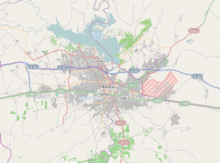
Adana is on the major route that connects Europe to the Middle East. In the 16th century, Adana was a port city where ships could navigate on Seyhan River to the port just south of Taşköprü.
Intercity transport
.jpg)
Şakirpaşa Airport lies just west of the old town. Together with the Central Bus Terminal and the Central Train Station, the three are the main locations for intercity transportation.
Şakirpaşa Airport, located within the city, is an international airport serving the Çukurova region. It is the sixth busiest airport in Turkey for passenger traffic, with 5.4 million passengers in 2015.[126] There are international flights to major cities of Germany, to Beirut, Jeddah, Erbil and Nicosia (TRNC), frequent domestic flights to Istanbul, Ankara, İzmir, Antalya, Trabzon, Bodrum and Van.[127]
Turkish State Railways (TCDD) runs five long distance lines that connect Adana to Ankara, Kayseri, Karaman, Konya and Elâzığ. All these lines are served at the Central Railway Station; some are also served at the other railway stations of the city—Şehitlik and Şakirpaşa stations at the west, Kiremithane, İncirlik and Yakapınar stations at the east. TCDD also runs three regional lines in Çukurova. Adana-Mersin Line runs as a commuter train with 27 train times daily.[128] Train service from Adana to Osmaniye–Islahiye[129] and to Iskenderun run once daily. Regional trains stop at all city stations.
Although they lost their popularity as private airlines introduced inexpensive flights to major cities, coaches are still the major form of transportation to and from Adana. Adana has two intercity coach terminals providing service to almost all the cities and towns in Turkey. Coach companies that serve transportation to cities west of Adana, depart from Central Coach Terminal, whereas the buses that serve cities east of Adana depart from Yüreğir Coach Terminal. A shuttle service is provided between the two terminals. Regional bus services from Adana to other places in Çukurova are plentiful and carried by bus and minibus co-operatives. Seasonal bus services to the high plains of Tekir, Bürücek and Kızıldağ run in summer, due to high demand of Adana residents escaping the heat of the city.
There is an extensive motorway network (O50-O59) in the region, connecting Adana to as far as Erdemli in the west, Niğde in the north, Şanlıurfa in the east and Iskenderun in the south. Traffic runs smoothly throughout the day; driving can take as little as 40 minutes to Mersin and two hours to Gaziantep.
Local transport
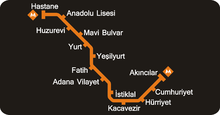
Local transport in Adana is provided by Adana Transit Corporation (a division of the Metropolitan Municipality) and by dolmuş and bus co-operatives. Transit Corporation runs the metro and the municipal buses.
Adana Metro is a rail rapid transit system that extends 14 kilometres (9 miles) from the north-west to the city center and then to Yüreğir.[130] The metro serves 13 stations and can transport 21,600 passengers per hour one-way, a complete journey taking 21 minutes. The second line of the metro will run from Akıncılar to Çukurova University in the Sarıçam District. It will be 9.5 kilometres (6 miles) long and will have seven stations. The project is contracted in January 2010 and the construction is expected to start after the funding is received from the Ministry of Transportation.[131] Adana Metro will eventually extend to 23.5 kilometres (14.6 miles) and serve 20 stations.[132]
Adana Transit Corporation serves the city with 229 buses, eight of them designed specifically for disabled users. Payment is collected by Kentkart Smartcard system. Six Bus Co-operatives (known as Can buses) serve the city with 411 buses. Kentkart and cash are accepted at these buses. 18 Dolmuş Co-operatives, with a total of 1,086 minibuses, provide service even to secondary streets. The only form of payment is by cash.
Cycling and walkability
The city of Adana is mostly flat and the warm weather makes it convenient for all year cycling and walking. The square shape of the city, city center's location right at the center of the square and the river running straight north–south in the middle of the city create further advantage for cycling as a means of transportation. Compact urban form due to dominance of high-rise buildings that are closely built, especially in Seyhan and Çukurova districts, make cycling from any end of the city to the city center to take less than 40 minutes. Despite all the advantages, car-oriented urban planning since the 1950s caused cycling to take a minor part in commuting to work or school. There are no bike lanes, but there are two bike paths, one along Fuzuli Street, the other along M. Kemalpaşa Boulevard—the latter not used by cyclists at all. Bicycles for commuting are currently only used by residents of low-income neighborhoods. Bicycle use for transportation is low all over Turkey,[133] but when compared to cities like İzmir, Konya and Eskişehir, Adana is less bicycle friendly.
Car-oriented urban planning became even more extreme since the 1980s, pedestrians seeing part of the sidewalks of the city's popular streets being converted into car-parking spots. The rise in car ownership not only caused high traffic, but also led to drivers parking their cars on the sidewalks. The city currently has no car-free squares or streets other than a few narrow ones. There are plans to convert both ends of Taşköprü to squares and widen the sidewalks in the old town where it is difficult to walk at the peddler-invaded narrow sidewalks. By far the most pedestrian friendly street of the city is Turgut Özal Boulevard; Kenan Evren and other major streets in Çukurova district are also very convenient for walking.
International relations
Adana is twinned with:
|
Europe
|
Asia
|
Gallery
 Adana Yeni Camii (New Mosque) Side view
Adana Yeni Camii (New Mosque) Side view Adana Yeni Camii (New Mosque) Entrance to courtyard
Adana Yeni Camii (New Mosque) Entrance to courtyard Adana Yeni Camii (New Mosque) Entrance to courtyard's backside
Adana Yeni Camii (New Mosque) Entrance to courtyard's backside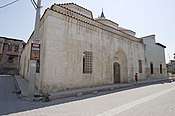 Adana Hasan Ağa mosque Exterior
Adana Hasan Ağa mosque Exterior Adana Hasan Ağa mosque Courtyard
Adana Hasan Ağa mosque Courtyard Adana Hasan Ağa mosque Mihrab and minber
Adana Hasan Ağa mosque Mihrab and minber Adana Hasan Ağa mosque Woodwork under balcony
Adana Hasan Ağa mosque Woodwork under balcony Adana Hasan Ağa mosque Woodwork under balcony
Adana Hasan Ağa mosque Woodwork under balcony Adana Tahtalı Cami From west
Adana Tahtalı Cami From west Adana Tahtalı Cami From east
Adana Tahtalı Cami From east Adana Tahtalı Cami Interior
Adana Tahtalı Cami Interior Adana Ağca Mescit Exterior
Adana Ağca Mescit Exterior Adana Ağca Mescit Interior
Adana Ağca Mescit Interior Adana Ağca Mescit Decorative stonework
Adana Ağca Mescit Decorative stonework Adana Yesil Mescit Exterior
Adana Yesil Mescit Exterior Adana Yesil Mescit Window decoration
Adana Yesil Mescit Window decoration Adana Alidede Mosque Exterior
Adana Alidede Mosque Exterior Adana Alidede Mosque Interior
Adana Alidede Mosque Interior
See also
References
- "Archived copy". Archived from the original on 4 February 2016. Retrieved 4 February 2020.CS1 maint: archived copy as title (link)
- "Archived copy". Archived from the original on 4 February 2016. Retrieved 18 February 2018.CS1 maint: archived copy as title (link)
- "Archived copy". Archived from the original on 4 February 2016. Retrieved 1 January 2016.CS1 maint: archived copy as title (link)
- "Ermeni Kültür Varlıklarıyla Adana" (PDF). HDV Yayınları. Retrieved 12 March 2020.
- Osman Fikri Sertkaya, “ Adana, Begrek, Beyrek ve Elma Kelimelerinin Kökeni Üzerine”, Ankara Üniversitesi Dil ve Tarih Coğrafya Fakültesi Türkoloji Dergisi, S.12, (2012), pages 101-103 (Article)
- Anton, Charles (1841). Classical Dictionary: Containing an account of the principal proper names mentioned in ancient authors... New York: Harper & Brothers.
- "Memalik-i Osmaniye Tarih ve Coğrafya Lügatı" (in Turkish). archive.org. Retrieved 12 June 2020.
- "Resmi İstatistikler: İllerimize Ait Genel İstatistik Verileri" (in Turkish). Turkish State Meteorological Service. Archived from the original on 13 January 2019. Retrieved 13 January 2019.
- Ann E.Killebrew, 2013, The Philistines and Other Sea Peoples in Text and Archaeology, Society of Biblical Literature, page 659, ISBN 978-1589837218
- Fox, Robin Lane (2009) Travelling Heroes: In the Epic Age of Homer Alfred A. Knopf, , New York, pages 211-224, ISBN 978-0-679-44431-2
- Richard Price; Michael Gaddis (2005). The Acts of the Council of Chalcedon. Volume 1. Liverpool University Press. p. 122. ISBN 978-0-85323-039-7.
- Michel Le Quien, Oriens christianus in quatuor Patriarchatus digestus, (Paris 1740), Vol. II, coll. 881–882
- Pius Bonifacius Gams, Series episcoporum Ecclesiae Catholicae, Leipzig 1931, p. 435
- Annuario Pontificio 2013 (Libreria Editrice Vaticana 2013 ISBN 978-88-209-9070-1), p. 825
- Joshua J.Mark. "Cilicia Campestris". Ancient History Encyclopedia. Retrieved 21 February 2020.
- Kasım Ener. "Adana İl Yıllığı". Adana Valiliği. Retrieved 28 March 2020.
- Nicholas Morton (2020). The Crusader States and their Neighbours: A Military History, 1099-1187. Oxford University Press. p. 181. ISBN 978-0192557988.
- Prof. Dr. Yılmaz KURT, "Ramazanoğulları’nın Sonu: Adana’da Çemşid Bey İsyȃnı (1606-1607)", Tarihin İçinden, Ankara Üniversitesi
- Baysun, C. (1963), Cevdetpaşa Tezakir, İstanbul: Türk Tarih Kurumu Yayın No:11 Seri:17b, pp. 27–35
- Toksöz, Meltem (2010). Nomads, Migrants and Cotton in the Eastern Mediterranean: The Making of the Adana-Mersin Region, 1850-1908. Brill. ISBN 978-9004191051.
- Matossian, Bedross Der (2018), 1909:The Adana Massacres, New York: Greenhaven Publishing, pp. 25–57, ISBN 978-1534501201
- "106. yıldönümünde Adana Katliamı'nın ardındaki gerçekler". Agos Gazetesi. Retrieved 12 March 2020.
- Yeghiayan, Puzant (1970), Ատանայի Հայոց Պատմութիւն [The History of the Armenians of Adana] (in Armenian), Beirut: Union of Armenian Compatriots of Adana, pp. 211–272
- Raymond H. Kévorkian, "The Cilician Massacres, April 1909" in Armenian Cilicia, eds. Richard G. Hovannisian and Simon Payaslian. UCLA Armenian History and Culture Series: Historic Armenian Cities and Provinces, 7. Costa Mesa, California: Mazda Publishers, 2008, pp. 351–353.
- Kevorkian, Raymond H. (2015). Ermeni Soykırımı. Istanbul: İletişim. ISBN 978-9750517280.
- Kevorkian, Raymond (2011). The Armenian Genocide: Complete History. London: I.B.Taurus & Co.Ltd. ISBN 978-1848855618.
- Cemal Güven, Milli Mücadele'de Mustafa Kemal Paşa'nın Yabancılarla temas ve görüşmeleri, Eğitim Yayınevi, 2012, ISBN 978-605-4392-80-3
- Garabet K.Moumdjian, Cilicia under French Administration , academia.edu, 2007, _STRATAGEMS]
- Robert Farrer Zeidner, The Tricolor over the Taurus: The French in Cilicia and Vicinity, 1918-1922, Atatürk Supreme Council for Culture, Language and History, 2005, ISBN 978-975-16-1767-5, p. 250., During three days of stark terror, the Armenians panicked 40,000 Muslims into fleeing to the countryside.
- Moumjian, Garabet K. "Cilicia Under French Administration: Armenian Aspirations, Turkish Resistance, and French Stratagems" in Armenian Cilicia, pp. 457–489.
- Ankara Treaty, Franco-Turkish Agreement signed at Angora on October 20,1921, His Majesty's Stationary Office, London
- Benjamin Thomas White, A Grudging Rescue: France, the Armenians of Cilicia, and the History of Humanitarian Evacuations, Humanity: An International Journal of Human Rights, Humanitarianism, and Development, Volume 10, Number 1, Spring 2019, pp. 1-27 (Article), University of Pennsylvania Press,
- "Adana araştırması ve saha çalışması". Hrant Dink Foundation. Retrieved 12 March 2020.
- "Bourj Hammmoud". bourjhammoud.com. Retrieved 29 January 2020.
- "Adana'dan Buenos Aires'e uzun bir yolculuk". Agos Gazetesi. Retrieved 29 January 2020.
- "Sabancıların İmparator olması". Retrieved 30 April 2020.
- Esref Yalcinkaya (2005). "Stochastic Finite-fault Modeling of Ground Motions From the June 27, 1998 Adana–Ceyhan earthquake" (PDF). Earth Planets Space. 57: 107–115.
- "5216 sayılı Büyükşehir Belediyesi Kanunu" (in Turkish). Grand National Assembly of Turkey. Archived from the original on 27 July 2010. Retrieved 26 July 2010.
- "5302 sayılı İl Özel İdaresi Kanunu" (in Turkish). Ministry of Justice. Archived from the original on 3 September 2011. Retrieved 21 July 2010.
- "5216 sayılı Büyükşehir Belediyesi Kanunu". Grand National Assembly of Turkey. Archived from the original on 27 July 2010. Retrieved 26 July 2010.
- "Adana Büyükşehir Belediyesi Tarihçesi" (in Turkish). Adana Metropolitan Municipality. Archived from the original on 31 July 2010. Retrieved 26 July 2010.
- "Karataş Belediyesi Büyükşehir'e Bağlanma Kararı Aldı" (in Turkish). Haberler.com. Retrieved 3 February 2012.
- "Adana Büyükşehir Belediyesi Meclis Üyeleri" (in Turkish). Adana Metropolitan Municipality. Archived from the original on 15 September 2010. Retrieved 27 July 2010.
- "Adana Büyükşehir Belediyesi Encümeni" (in Turkish). Adana Metropolitan Municipality. Archived from the original on 12 June 2010. Retrieved 27 July 2010.
- "Yeni Adana Projesi" (in Turkish). Adana Metropolitan Municipality. Archived from the original on 15 September 2010. Retrieved 4 September 2010.
- "Sağlık Kampüsü Yüreğir'e". haber01.com. Archived from the original on 15 December 2018. Retrieved 4 September 2010.
- "Adana'da Kentsel Donusum". Kentsel Haber. Archived from the original on 13 July 2011. Retrieved 18 August 2009.
- Koçberber, Seyit (2007), Yeni Belediye Yasası ile Mahalle Yönetimi (in Turkish), 56, Sayıştay Journal, pp. 103–114
- "Adana Kenti İlçe Mahalle ve Muhtarlıklar" (in Turkish). Metropolitan Municipality. Archived from the original on 15 September 2010. Retrieved 27 July 2010.
- "Bekleyen dev: Adana". Aksiyon. Archived from the original on 4 January 2014. Retrieved 2 February 2012.
- "Adana'da sanayi tasfiye oluyor.(Turkish)". Vatan Gazetesi. Archived from the original on 16 June 2013. Retrieved 9 March 2009.
- "Adana'da 5 kişiden biri işsiz(Turkish)". Radikal Gazetesi. Retrieved 24 June 2011.
- "European Regions of the Future". Foreign Direct Investment Magazine. Archived from the original on 11 March 2007.
- "Adana Exhibition and Congress Center". TÜYAP. Archived from the original on 13 November 2008.
- "ÇÜ'de, 2 bin kişilik kültür ve kongre merkezi temeli atıldı (Turkish)". Zaman Gazetesi. Archived from the original on 28 September 2011. Retrieved 15 May 2008.
- "ATO Tarihçe (Turkish)". Adana Chamber of Commerce. Archived from the original on 15 June 2012. Retrieved 5 February 2012.
- "Adana Ticaret Borsası Tarihçe (Turkish)". Adana Commodity Exchange. Archived from the original on 11 April 2012. Retrieved 5 February 2012.
- "Adana Otel Yatırımcılarının Yeni Gözdesi Oldu". Haberler.com.
- "Hotels in Adana". ÇUKTOB. Archived from the original on 19 January 2010.
- "İllere göre tarım miktarları". Turkcebilgi.net. Archived from the original on 29 April 2010.
- "Çukobirlik Tarihçe". Çukobirlik. Retrieved 4 February 2012.
- "Adana Tarım Fuarı'na 20 Ülkeden Katılımcı Geliyor". Haberler.com.
- "Distribution Of Sectors in Adana" (PDF) (in Turkish). Adana Chamber of Industry. Retrieved 14 October 2016.
- "Türkiye'nin en büyük 500 sanayi kuruluşu arasına Adana'dan sadece 11 firma girdi (Turkish)". Zaman Gazetesi.
- "Marsan Adana Plant". Marsan. Archived from the original on 4 October 2009.
- "Advansa Adana Plant". Advansa.
- "Biruni". Biruni.tuik.gov.tr. Archived from the original on 18 February 2019. Retrieved 4 February 2020.
- "Adana Tarihi (Turkish)". Mekan360. Archived from the original on 14 July 2014. Retrieved 25 January 2012.
- The Plain of Saints and Prophets: The Nusayri-Alawi Community of Cilicia, Gisela Procházka-Eisl, Stephan Procházka, p. 39
- "1910'larda kimine göre 2.5 milyon, kimine göre 4.5 milyon Kürt göç ettirildi.(Turkish)". Radikal. Retrieved 28 January 2012.
- "Distribution of Ethnic Groups in Turkey (Turkish)". Habername. Retrieved 6 June 2008.
- "Hangi ilde ne kadar çingene yaşıyor? (Turkish)". Son Sayfa.
- "Gizli Ermeniler (Turkish)". AZSAM. Archived from the original on 1 May 2011. Retrieved 27 December 2008.
- Herbermann, Charles, ed. (1913). . Catholic Encyclopedia. New York: Robert Appleton Company.
- "Adana'dan Buenos Aires'e uzun bir yolculuk". Agos Gazetesi. Retrieved 29 January 2020.
- "Amerikalı asker sayısı azaldı. (Turkish)". CİHAN News Agency. Archived from the original on 17 July 2011. Retrieved 18 September 2008.
- "Adana Taşköprü (Stone Bridge)". Governship of Adana Tourism and Culture Department.
- "Çarşı Hamamı(Turkish)". Kenthaber Kültür Kurulu. Archived from the original on 4 October 2009.
- "Sabancı Merkez Camii". Sabancı Vakfı.
- "Adana". Adonis İstanbul. Archived from the original on 11 March 2010.
- "Yeni Camii". Kenthaber Kültür Kurulu. Archived from the original on 5 October 2009.
- Cezmi Yurtsever. "Kiikya Ermenileri". Cezmiyurtsever.com. Archived from the original on 8 July 2011.
- "Rekreasyon Çalışmaları". Adana Metropolitan Municipality. Archived from the original on 22 August 2014.
- "Çukurova Süleyman Demirel Arboretumu (Turkish)". Adana Orman Bölge Müdürlüğü.
- Erman Artun. "Adana Halk Kültürüne bakış". Çukurova Üniversitesi Türkoloji Araştırmaları Merkezi.
- "Adana Mutfağı(Turkish)". adanadan.biz.
- "Adana Devlet Tiyatrosu Tarihçesi(Turkish)". Adana Devlet Tiyatroları. Archived from the original on 9 September 2009.
- "Misis Mozaik Müzesi (Turkish)". Buneki.
- "Müzelere öğrenci ilgisi (Turkish)". Haberler.com. Retrieved 12 February 2012.
- "13th State Theater-Sabancı International Adana Theater Festival". Sabancivakfi.org. Archived from the original on 4 April 2011. Retrieved 2 October 2014.
- "Nisan'da Adana'da". Nisandaadanada.com. Retrieved 19 January 2016.
- "5.Uluslararası Çukurova Çoksesli Müzik Festivali(Turkish)". Çukurova Müzik Dostları Derneği. Archived from the original on 5 January 2010.
- "6. Uluslararası Çukurova Sanat Günleri (Turkish)". Son Dakika. Retrieved 26 March 2012.
- İbrahim Altay. "Adana artık pavyonla anılmıyor.(Turkish)". Sabah Gazetesi. Retrieved 11 February 2012.
- İbrahim Altay. "Adana'da bar-pavyon hayatı". Sabah Gazetesi.
- İbrahim Altay. "Tele-bar Furyası (Turkish)". Sabah Gazetesi.
- "Rakıcılar bir kez daha Dünya Rakı Gününde buluşuyor". Cnnturk.com. 27 November 2014. Retrieved 19 January 2016.
- Tekin İdem (2015) Journal of History Schools, Volume 8, Part 22, Ahmet Remzi Yüreğir'in Hayatı ve 8.Yasama Dönemi Meclis Faaliyetleri, Batman Üniversitesi, Batman, Türkiye page 325
- Hayk Demoyan (editor) (2014) International Journal of Armenian Genocide Studies, Volume 1, Part 1, Patriotism, Competitive Nationalism and Minority's Success: Armenian Sports in the Ottoman Empire pre-1915 period, Tigran Mets Publishing House, Yerevan, Armenia, page 21
- "Avrupa Tekerlekli Sandalye Basketbol Şampiyonası Adana'da başladı.(Turkish)". Haberler.gen.al.
- "2013 Dünya Gençler Tekerlekli Sandalye Basketbol Şampiyonası'na doğru(Turkish)". Haberler.com.
- "Volleyball VII European Championship 1967". Todor66.com. Archived from the original on 27 May 2016. Retrieved 28 May 2016.
- "Adanaspor, Spor Toto Süper Lig'de – TFF'den Mesajlar Detay Sayfası TFF". Tff.org. 24 April 2016. Retrieved 28 May 2016.
- "Türkiye 1. Basketbol Ligi'nde Adanaspor küme düştü". Karar.com. Retrieved 28 May 2016.
- "Türkiye Voleybol Federasyonu". Tvf.org.tr. 24 May 2016. Archived from the original on 21 April 2016. Retrieved 28 May 2016.
- "Adana Byz Algomed Spor İddiali". Gazeteolay.com. Retrieved 19 January 2016.
- "Adana Şakirpaşa HEM SK Süper Ligde – Haberler". Thf.gov.tr. 21 April 2016. Archived from the original on 8 May 2016. Retrieved 28 May 2016.
- "> LİGLER > Bayanlar 1. Lig". Thf.gov.tr. Archived from the original on 2 June 2016. Retrieved 28 May 2016.
- "Adana Demirspor Tarihçe (Turkish)". Adana Demirspor Club. Archived from the original on 14 January 2010.
- "Adana'da Yelken Heyecanı (Turkish)". Adana Metropolitan Municipality.
- "Büyükşehir'den 7 Yeni Havuz(Turkish)". Haberler.com. Archived from the original on 3 February 2016. Retrieved 1 February 2012.
- "Adana'da yağmura rağmen maraton büyük ilgi gördü.(Turkish)". Adana Büyükşehir Belediyesi.
- "Adana Uluslararası Kurtuluş Yarı Maratonu'na Doğru(Turkish)". Haberler.com.
- "Archived copy". Archived from the original on 23 May 2009. Retrieved 30 September 2009.CS1 maint: archived copy as title (link)
- "Schools in Adana". Adana Governorship Education Department. Archived from the original on 4 October 2009.
- "Adana İl Halk Kütüphanesi Tarihçe (Turkish)". Adana İl Halk Kütüphanesi Müdürlüğü. Archived from the original on 3 April 2012.
- "Adana Kent Kütüphanesi Hakkında(Turkish)". Adana Kent Kütüphanesi. Archived from the original on 14 July 2014. Retrieved 2 February 2012.
- "Çukurova 5.Kitap Fuarı sona erdi. (Turkish)". Turkish Publishers Association. Archived from the original on 22 December 2012. Retrieved 8 February 2012.
- "Dershaneler Dosyası (Turkish)". Ankara Chamber of Commerce. Archived from the original on 4 March 2016.
- "ISLAMIC STATES: Network to improve quality assurance". University World News. Retrieved 28 June 2009.
- "Dünyanın en iyileri arasında 5 Türk üniversite (Turkish)". Star Gazete. Retrieved 23 January 2008.
- "ÇÜ'de Öğrenci Kayıtları (Turkish)". Haber FX. Archived from the original on 23 July 2011.
- "Adana'ya bilim üniversitesi(Turkish)". Radikal. Retrieved 31 March 2011.
- "Çukurova Üniversitesi Tıp Fakültesi(Turkish)". Çukurova Üniversity. Archived from the original on 26 April 2012. Retrieved 2 January 2012.
- "Adana'ya 400 milyon TL'lik Sağlık Kampüsü yapılacak(Turkish)". Medikal Plus. Archived from the original on 26 April 2012. Retrieved 2 January 2012.
- "DHMİ İstatistikler(Turkish)". DHMİ. Archived from the original on 28 June 2015. Retrieved 7 January 2016.
- "Pegasus, Adana merkezli Diyarbakır ve Van uçuşlarına başladı(Turkish)". Dünya Gazetesi. Archived from the original on 8 November 2010. Retrieved 3 November 2010.
- "Adana -Mersin Hızlı Tren Seferleri Başlıyor (Turkish)". Anadolu Ajansı. Archived from the original on 23 November 2009. Retrieved 19 November 2009.
- "Islahiye-Adana Regional Train". Todd.gov.tr. Archived from the original on 21 September 2014. Retrieved 2 October 2014.
- "Adana Hafif Raylı Taşıma Sistemi Devreye Girdi. (Turkish)". Anadolu Ajansı. Retrieved 14 May 2010.
- "Metronun İkinci Etap İhalesi Başlıyor. (Turkish)". Adana Medya. Archived from the original on 13 January 2010.
- "İkinci Etap Raylı Taşıma Sistemi Projesi 210 milyon dolara mal olacak (Turkish)". Adana Haber. Archived from the original on 3 September 2011. Retrieved 12 April 2011.
- Volkan Emre Uz, Mustafa Karaşahin (2004). "Kentiçi ulaşımda bisiklet" (PDF). Türkiye Mühendislik Haberleri. 429 2004/1: 41–46.
- "Adana ve Debrecen kardeş şehir oldu". Hürriyet.
- "International Relations of the City of Beersheba" (in Hebrew). Beersheba Municipality. Archived from the original on 9 December 2008. Retrieved 6 December 2008.
Further reading
- Parpola, Simo; Porter, Michael (2001). The Helsinki Atlas of the Near East in the Neo-Assyrian Period. Helsinki, Finland: Gazetteer. ISBN 951-45-9050-3.
- Mango, Andrew (2004). The Turks Today. New York City: The Overlook Press. ISBN 1-58567-756-6.
- Talbert, Richard (2004). Barrington Atlas of the Greek and Roman World. New York City: The Overlook Press. ISBN 0-691-03169-X.
- Yeghiayan, Puzant (1970). Ատանայի Հայոց Պատմութիւն [The History of the Armenians of Adana] (in Armenian). Beirut: Union of Armenian Compatriots of Adana.
External links
| Wikivoyage has a travel guide for Adana. |
| Wikimedia Commons has media related to Adana. |
